-
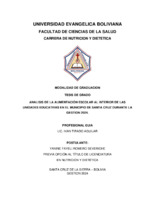 Análisis de la alimentación escolar al interior de las unidades educativas en el Municipio de Santa Cruz de la Sierra durante la gestión 2024.
Análisis de la alimentación escolar al interior de las unidades educativas en el Municipio de Santa Cruz de la Sierra durante la gestión 2024. Este trabajo de investigación tiene como objetivo realizar un análisis exhaustivo sobre la alimentación en las unidades educativas del municipio de Santa Cruz durante la gestión 2024. En un contexto donde la nutrición infantil es fundamental para el desarrollo físico y cognitivo de los estudiantes, la Unidad de Alimentación y Nutrición del Ministerio de Salud ha subrayado la importancia de priorizar una alimentación saludable en niños y niñas en edad escolar, específicamente en el grupo etario de 9 a 12 años. Esta etapa de crecimiento y desarrollo se caracteriza por cambios físicos significativos, y es crucial asegurar que se satisfagan los requerimientos nutricionales de los menores. El informe presentado por la Organización Panamericana de la Salud (OPS) y la Organización Mundial de la Salud (OMS) destaca una problemática alarmante en Bolivia: la prevalencia total de sobrepeso y obesidad en escolares de entre 5 y 18 años ha superado el 35,6%. Este dato pone de manifiesto una crisis de salud pública, ya que la obesidad infantil se asocia con una serie de patologías graves, incluyendo hipertensión, diabetes y alteraciones en los niveles lipídicos. Estas condiciones, que pueden manifestarse desde la niñez, aumentan el riesgo cardiovascular a lo largo de la vida, haciendo imprescindible la implementación de estrategias para contrarrestar esta tendencia. Con base en esta problemática, se llevará a cabo un análisis que incluirá la implementación de snacks saludables en las unidades educativas del municipio. Esta estrategia no solo busca mejorar la calidad nutricional de las meriendas consumidas por los estudiantes, sino también promover un cambio en los hábitos alimenticios. Para complementar esta iniciativa, se realizarán talleres, dinámicas y charlas educativas dirigidas tanto a los estudiantes como a los padres de familia.
-
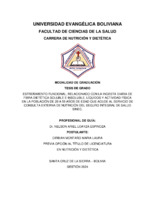 Estreñimiento funcional, relacionado con la ingesta diaria de fibra dietética soluble e insoluble, líquidos y actividad física en la población de 20 a 59 años de edad que acude al servicio de consulta externa de nutrición del Seguro Integral de Salud SINEC.
Estreñimiento funcional, relacionado con la ingesta diaria de fibra dietética soluble e insoluble, líquidos y actividad física en la población de 20 a 59 años de edad que acude al servicio de consulta externa de nutrición del Seguro Integral de Salud SINEC. Este trabajo de investigación tiene como objetivo determinar el principal factor de riesgo para el estreñimiento funcional, cuantificando la ingesta diaria de fibra dietética soluble e insoluble, líquidos y actividad física en la población de 20 a 59 años de edad que acude al servicio de consulta externa de Nutrición del Seguro Integral de salud SINEC en la gestión 2023
La constipación o estreñimiento, es un problema común con una prevalencia del 2 al 27% de la población mundial, incluida Latinoamérica. Montalvo (2013), en un artículo sobre sostiene que la situación en Latinoamérica es muy preocupante, ya que muestra porcentajes elevados de estreñimiento crónico y las personas que los padecen el 75% utilizan algún tipo de medicación, el 27% se auto medican, el 50% utilizan medicamentos caseros y solo el 38% de personas consumen fibra.
El presente estudio tiene un enfoque cuantitativo, correlacional, descriptivo de asociación cruzada y transversal, debido a que se medirá el grado de relación que existe entre las variables, las cuales no se manipulan ni controlan los datos, sobre una determinada población de muestra, recopiladas en un periodo de tiempo.
Según el tipo de heces evacuadas, medida a través de la escala de Bristol, observamos que en la población de estudio el 19, 4% y 1,4% presenta el tipo 2 y tipo 1 respectivamente el cual representa a heces duras, y transito lento (constipación), de 144 pacientes encuestados, 30 (20,83%) de la población presenta estreñimiento funcional en los cuales se basó el estudio, para establecer los factores de riesgo.
Según los datos de riesgo, los pacientes con estreñimiento funcional, cuya ingesta de Fibra dietética es inferior a la necesaria, tienen 2,5 veces más probabilidad de presentar el padecimiento y los sedentarios 2,22 veces, en cuestión a la ingesta de líquidos, es un factor de riesgo incluso aún mayor, ya que existe 3,35 veces mayor probabilidad de presentar estreñimiento. Sin embargo lo más destacable, es la variable proporción del tipo de fibra soluble e insoluble, ya que con proporciones inadecuadas existe 22,25 veces mayor probabilidad de presentar estreñimiento funcional, por lo tanto, constituye el principal factor de riesgo de este estudio.
-
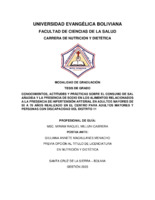 Conocimientos, actitudes y prácticas sobre el consumo de sal añadida y la presencia de sodio en los alimentos relacionados a la presencia de hipertensión arterial en adultos mayores de 50 a 70 años realizado en el centro para adultos mayores y personas con discapacidad del distrito 11
Conocimientos, actitudes y prácticas sobre el consumo de sal añadida y la presencia de sodio en los alimentos relacionados a la presencia de hipertensión arterial en adultos mayores de 50 a 70 años realizado en el centro para adultos mayores y personas con discapacidad del distrito 11 La presente investigación analiza los conocimientos, actitudes y prácticas (CAP) sobre el consumo de sal añadida y la presencia de sodio en los alimentos, y su relación con la hipertensión arterial en adultos mayores de 50 a 60 años. El objetivo principal es identificar los patrones de comportamiento y niveles de conciencia en este grupo demográfico sobre los riesgos asociados al consumo elevado de sodio, un factor clave en el desarrollo de la hipertensión.
Este estudio abarca una evaluación del nivel de conocimiento de los participantes, enfocándose en los efectos del sodio en la salud. También incluye la identificación de las fuentes alimentarias que contienen sodio en exceso, como los alimentos procesados, embutidos, conservas y comidas rápidas, que son de consumo frecuente en muchos casos. Se analiza la relación directa entre la ingesta elevada de sal y la aparición de hipertensión arterial, lo que permite comprender cómo las elecciones alimentarias y el uso frecuente de sal influyen directamente en el desarrollo de esta enfermedad.
Además de este enfoque principal, el estudio toma en cuenta otros factores que podrían potenciar los efectos del consumo elevado de sodio, como la edad, el género y el nivel educativo de los participantes. Estos factores permiten obtener una perspectiva más completa sobre cómo varía la influencia del sodio en distintas personas. Por otro lado, la investigación revisa las recomendaciones diarias de consumo de sodio y cómo estas se comparan con las prácticas actuales de los participantes, lo que contribuye a identificar las posibles brechas entre el conocimiento y la aplicación de hábitos saludables.
Así mismo, se analizarán sus actitudes hacia la reducción del sodio en la dieta, además se identificarán las prácticas alimentarias cotidianas relacionadas con el uso de sal y el consumo de alimentos procesados ricos en sodio. Esto permitirá comprender las barreras y facilitadores para la adopción de hábitos alimenticios más saludables en esta etapa de la vida.
La investigación busca no solo identificar factores que incrementan el riesgo de hipertensión, sino también examinar las brechas en el conocimiento y la aplicación de medidas preventivas. Además, se consideran los factores culturales que pueden influir en los hábitos alimentarios de este grupo demográfico. Finalmente, se proponen recomendaciones prácticas y específicas para el diseño de intervenciones educativas, enfocadas en mejorar
-
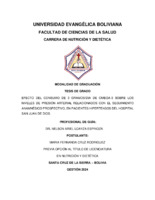 Efecto del consumo de 3 gramos/día de omega-3 sobre los niveles de presión arterial relacionados con el seguimiento anamnésico prospectivo, en pacientes hipertensos del Hospital San Juan de Dios.
Efecto del consumo de 3 gramos/día de omega-3 sobre los niveles de presión arterial relacionados con el seguimiento anamnésico prospectivo, en pacientes hipertensos del Hospital San Juan de Dios. La hipertensión arterial es una enfermedad crónica no transmisible caracterizada por el aumento persistente de la presión sanguínea en las arterias. En Bolivia, afecta a 6,904 personas por cada 100,000 habitantes, con una prevalencia del 18% entre adultos de 25 a 60 años en ciertas regiones. Esta condición representa un importante factor de riesgo para enfermedades cardiovasculares, diabetes, síndrome metabólico y enfermedad renal. Medidas preventivas efectivas incluyen la reducción del consumo de sal, la adopción de una dieta rica en frutas y verduras, la práctica regular de actividad física, el mantenimiento de un peso saludable y el cumplimiento del tratamiento médico. La implementación de estas estrategias no solo ayuda a controlar la hipertensión, sino que también previene complicaciones asociadas como infartos de miocardio y accidentes cerebrovasculares, mejorando así los resultados de salud pública.
Los ácidos grasos omega-3 son una forma de grasa poliinsaturada que el cuerpo obtiene de los alimentos. El Omega-3 es conocido como ácidos grasos esenciales debido a que el cuerpo no puede producirlos por sí solo, de tal manera que los debe obtener de los alimentos o mediante suplementación para lograr cubrir los requerimientos y que así cumplan su función en nuestro cuerpo con múltiples beneficios.
El objetivo de este estudio es suplementar con ácidos grasos 3 gramos/día de omega-3 a la población con hipertensión y determinar el efecto que esta tiene sobre los niveles de presión arterial, acompañado también de seguimiento nutricional mediante anamnesis alimentaria y toma de talla/peso y de la presión arterial a los pacientes del grupo de estudio.
El estudio se realizó en el hospital San Juan de Dios en el departamento de Santa Cruz, Bolivia; donde el grupo de estudio estaba conformado por 60 pacientes hipertensos de rango de edad entre 30 a 60 años. Donde 30 pacientes son de grupo experimental y 30 de grupo control. En el grupo experimental que recibió 3 gramos diarios de omega-3, se observaron mejoras significativas en los niveles de presión arterial sistólica a lo largo del estudio, con notables aumentos en la categoría de presión normal y reducciones en las categorías de presión alta y crisis hipertensiva. En contraste, el grupo control mostró mejoras menos marcadas. Respecto a la presión arterial diastólica, el grupo experimental también experimentó mejoras notables, especialmente en la normalización de la presión y reducciones en los niveles más altos de presión. Estos hallazgos sugieren
-
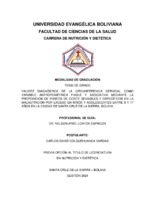 Validez diagnóstica de la circunferencia cervical como variable antropométrica fiable y asociativa mediante la proposición de puntos de corte sensibles y específicos en la malnutrición por exceso en niños y adolescentes entre 8 y 17 años en la Ciudad de Santa Cruz de la Sierra, Bolivia.
Validez diagnóstica de la circunferencia cervical como variable antropométrica fiable y asociativa mediante la proposición de puntos de corte sensibles y específicos en la malnutrición por exceso en niños y adolescentes entre 8 y 17 años en la Ciudad de Santa Cruz de la Sierra, Bolivia. Para el diagnóstico de la obesidad, uno de los indicadores tradicionales y más útiles es el Índice de masa corporal (IMC), recomendado por varios comités tanto para los adultos como para niños y adolescentes. Sin embargo, esta tiene sus limitaciones y puede clasificar de forma errónea debido a la presencia de factores como: desarrollo muscular, tamaño del cráneo, un torso prominente, entre otros. De tal forma, que se convierte en no-viable a la hora de determinar volumen de la masa grasa
En este entendido, el objetivo del presente trabajo yace en la exploración de la validez diagnóstica de la circunferencia cervical como variable antropométrica asociativa de diagnóstico de la malnutrición por exceso (sobrepeso, obesidad, obesidad severa).
El enfoque del presente estudio es de tipo cuantitativo, descriptivo – explicativo, de campo, de carácter prospectivo y transversal entre los meses de septiembre y noviembre de 2023. El levantamiento de datos involucró la medición de 1365 estudiantes de los diferentes colegios del municipio de Santa Cruz de la Sierra, los sujetos de la muestra rondan entre los 8 a 17 años y un rango de talla que oscila entre 120 a 180 centímetros.
La distribución de la prevalencia de la malnutrición por exceso, el cual es una variable combinatoria de sobrepeso, obesidad y obesidad severa según género muestra que el grupo más afectado son los estudiantes varones, que tienen una tasa de malnutrición del 46,5%, frente al 41,1% de prevalencia en las estudiantes mujeres. Asimismo, Se pusieron bajo la lupa a tres variables: circunferencia cervical (Ccu), circunferencia de la cintura (Cci) o abdominal, y el IMC. La correlación entre el Ccu (r = 0,627 para niñas, y r=0,631 para niños) y el IMC es ligeramente menor a la correlación del Cci con el IMC (r=0,778 para niñas y r=0,787 para niños). Esto se puede interpretar que hay una mejor sinergia entre el Cci y el IMC, sin embargo, también hay que destacar la correlación entre el Ccu y el Cci, el cual también tiene una alta fuerza correlativa-asociativa (r=0,747 para niñas y r=0,764 para niños.
Una vez, establecida la validez diagnóstica moderada, se procedió a realizar los correspondientes cálculos de sensibilidad y especificad con el propósito de establecer propuestas de puntos de corte de normalidad para cada rango-edad y rango-talla obtenidos a través del método estadístico de Curvas ROC y razones de verosimilitud positiva y negativa.
-
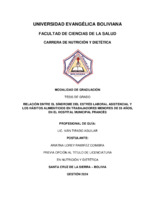 Relación entre el síndrome del estrés laboral asistencial y los hábitos alimenticios en trabajadores menores de 55 años, en el Hospital Municipal Francés
Relación entre el síndrome del estrés laboral asistencial y los hábitos alimenticios en trabajadores menores de 55 años, en el Hospital Municipal Francés La alimentación junto con los factores psicológicos son temas de suma importancia en un trabajador, por lo que los hábitos alimenticios afectan el desarrollo en la persona afectando la salud tanto nutricional como psicológica, de igual manera que el estrés laboral puede presentar signos y síntomas preocupantes en la persona que llegan a afectar el organismo de distinta forma.
Por este motivo es que la presente investigación se llevó a cabo con el objetivo de identificar la relación que existe entre el síndrome de estrés laboral asistencial y los hábitos alimenticios en trabajadores. La investigación presenta un enfoque cuantitativo de tipo no experimental con diseño transversal.
La investigación se realizó mediante el Test Burnout de Maslach para identificar el Síndrome de estrés laboral asistencial (Síndrome de Burnout), el Índice de Alimentación Saludable se utilizó para identificar los hábitos alimenticios, utilizando el cuestionario de Willet y el test de Block desarrollados en la investigación de un estudio en Uruguay, cambiando los grupos alimenticios de acuerdo a la guía alimentaria boliviana.
Se consideró un muestreo no probabilístico por conveniencia, obteniendo una población con cuatrocientas personas aproximadamente, alcanzando una muestra de 277 personas en el Hospital Municipal Francés, donde se encuestó durante el mes de septiembre y octubre, realizando también una actividad extra en la institución. Se trabajó la base de datos en los Software SPSS y Excel para obtener resultados concisos, donde se consideró mayor porcentaje en mujeres que hombres con poca diferencia, tomado en cuenta como variable interviniente, además de peso, talla, edad, estado civil, tiempo en su trabajo actual, cargo laboral, situación laboral.
Si bien los resultados entre estrés laboral asistencial (Burnout) y el Índice de Alimentación Saludable (IAS), se evidenció una relación muy débil, aunque positiva con Cansancio Emocional y Realización Personal, también se demostró la presencia de estrés laboral asistencial en más de la mitad de la muestra encuestada, explicando conforme se encuestaba los riesgos, factores del estrés laboral y lo que se considera una buena alimentación.
-
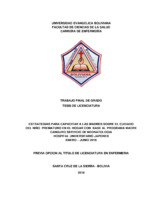 Estrategias para capacitar a las madres sobre el cuidado del niño prematuro en el hogar con base al programa madre canguro servicio de neonatología Hospital Universitario Japonés, enero – junio 2016
Estrategias para capacitar a las madres sobre el cuidado del niño prematuro en el hogar con base al programa madre canguro servicio de neonatología Hospital Universitario Japonés, enero – junio 2016 La presente investigación sobre estrategias para capacitar a las madres en el cuidado del niño prematuro en el hogar, con base al Programa Madre Canguro, fue realizado en el servicio de Neonatología del Hospital Universitario Japonés durante el periodo de enero a junio del 2016, con el objetivo de proponer un modelo de capacitación a las madres con base al Programa Madre Canguro para la prevención de las complicaciones del prematuro en el hogar.
La metodología es de tipo descriptivo, analítico y cuantitativo, cuyo universo estuvo compuesto por todas las madres de los niños prematuros que ingresaron al servicio de Neonatología del Hospital, se aplicó un test con preguntas cerradas relacionadas con todas las variables de la investigación.
Los resultados obtenidos fueron: 58% de los niños prematuros corresponden a prematuro moderado o tardío, 64% de los prematuros desarrollaron ictericia del prematuro, 35% de los niños prematuros tienen una madre de 15 años, 30% de las madres alcanzaron a estudiar solo la primaria. El 50% de las madres viven en unión libre, el 40% de las mamas tienen más de 6 hijos, el 35% se dedican al comercio, el 33% de los prematuros que volvieron como reingreso al hospital fue por hipotermia.
Se concluye mencionando que la edad de la madre influye en el nacimiento de los niños prematuros, los diagnósticos más frecuentes fueron la ictericia, apnea e hipoglicemia.
Las causas de reingresos fueron la hipotermia, neumonía, desnutrición y deshidratación, factores que están relacionados con la calidad del cuidado que brinda la madre en el hogar.
Capacitando a las madres sobre los cuidados del prematuro en el hogar se disminuirán los reingresos por complicaciones en los hospitales
-
 Experiencia de las madres durante la hospitalización de su hijo con quemaduras de 2do. y 3er. grado. sala de Quemados Hospital De Niños Dr. Mario Ortiz Suarez enero del 2016
Experiencia de las madres durante la hospitalización de su hijo con quemaduras de 2do. y 3er. grado. sala de Quemados Hospital De Niños Dr. Mario Ortiz Suarez enero del 2016 Los niños que tienen quemaduras de 2do y 3er grado, sufren un proceso traumático, debido al tiempo de recuperación y atención que necesitan. Sin embargo, no es solo el niño, sino todo el entorno familiar y especialmente la madre, porque ella en la mayoría de los casos es la que dedica su tiempo a la atención del niño, sufre muchos problemas como: falta de dedicación a los quehaceres del hogar o la ausencia a su fuente laboral; lo cual en muchos casos suele causar estrés y depresión.
Esta investigación se realizó con el objetivo de identificar las experiencias que viven las madres cuando uno de sus hijos sufre quemaduras y es hospitalizado por largo tiempo.
Para conocer la incidencia de niños se revisó los registros del Dpto. de Estadísticas, las historias clínicas y los registros de ingreso y egreso de la Sala.
Para identificar las experiencias de las madres se realizaron encuestas, se tabularon los resultados se proponen estrategias para mejorar la calidad de atención a las madres durante la hospitalización de sus hijos con quemaduras de 2do y 3er grado.
Los datos obtenidos demuestran que en el Hospital de Niños Dr. Mario Ortiz Suarez de la ciudad de Santa Cruz la incidencia de niños con quemaduras es alta, predominan en el sexo masculino
Los resultados obtenidos demuestran que durante la hospitalización de un niño con quemaduras las madres sufren de depresión y estrés.
-
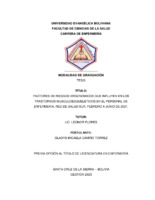 Factores de riesgos ergonómicos que influyen en los trastornos musculoesqueléticos en el personal de enfermería, Red de Salud Sur, febrero a junio de 2021.
Factores de riesgos ergonómicos que influyen en los trastornos musculoesqueléticos en el personal de enfermería, Red de Salud Sur, febrero a junio de 2021. Los trastornos musculoesqueléticos de origen laboral son alteraciones que sufren estructuras corporales como los músculos, articulaciones, tendones, ligamentos, huesos, nervios causadas fundamentalmente por el trabajo y efectos del entorno en el que se desarrolla.
Objetivo: Determinar los factores de riesgos ergonómicos que influyen en los trastornos musculoesqueléticos en el personal de Enfermería en la Red de Salud Sur febrero a junio 2021.
Metodología: El estudio fue desarrollado en base a parámetros de enfoque mixto, según su alcance es de tipo analítico porque se estudiará la variable independiente como la variable dependiente y se determinará su relación entre ambas, también se comprobará la hipótesis una vez obtenido el resultado, según su diseño este estudio es observacional porque simplemente se observa al problema sin controlar una variable, no existe intervención del investigador sobre los resultados, las mediciones reflejan la evolución natural de los eventos.
Resultados: En cuanto al personal que trabaja en la Red de Salud Sur, existe un 97% del sexo femenino y un 3% del sexo masculino, también describe el nivel académico del personal de enfermería que trabaja en los Centros de Salud, el 63% son licenciadas y 37% auxiliares de enfermería.
Un 58 % presentan trastornos musculoesqueléticos, siendo un mayor porcentaje en la región dorsal o lumbar con el 82%, seguido de un 75% en el cuello,45% en la región del hombro, 43% en la muñeca o mano, con un mínimo porcentaje de 34% en la región del codo o antebrazo.
Conclusiones: En cuanto a los riesgos ergonómicos que influye en la aparición de trastorno musculoesquelético predominó un nivel alto de sobre carga laboral, estés, al inadecuado uso de la mecánica corporal entre otros por las secuelas del Covid -19.
-
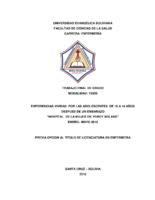 Experiencias vividas por las adolescentes de 10 a 19 años después de un embarazo “Hospital de la Mujer Dr. Percy Boland” Enero– Mayo 2015.
Experiencias vividas por las adolescentes de 10 a 19 años después de un embarazo “Hospital de la Mujer Dr. Percy Boland” Enero– Mayo 2015. Alcira Suarez Pariqui
-
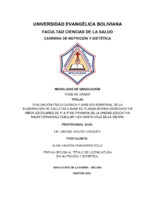 Evaluación físico-química y análisis sensorial de la
elaboración de galletas a base de plasma bovino desecado en niños escolares de Primero a Quinto de Primaria de la Unidad Educativa Naun Fernández Cuellar II en Santa Cruz de la Sierra, Bolivia.
Evaluación físico-química y análisis sensorial de la
elaboración de galletas a base de plasma bovino desecado en niños escolares de Primero a Quinto de Primaria de la Unidad Educativa Naun Fernández Cuellar II en Santa Cruz de la Sierra, Bolivia.
El objetivo de este trabajo de investigación fue realizar la evaluación físico-química y análisis
sensorial de galletas a base de plasma bovino desecado en polvo.
La Sociedad Agroindustrial SCANBIOTEK S.R.L., y parte del Grupo PROTENA INTERNACIONAL, se dedica a recolectar y procesar higiénicamente la sangre bovina de mataderos certificados por SENASAG, generando productos aptos para el consumo humano, aprovechando varios subproductos de los frigoríficos.
Teniendo en cuenta que la sangre tiene como subproducto el plasma bovino, que tiene un potencial nutritivo de proteínas de alto valor biológico, su utilización es básicamente en la producción de productos cárnicos, desaprovechando así su incorporación en otros productos como los de panificación.
Para esta investigación se ha aplicado el tipo de estudio explicativo, de campo con tipo muestreo no probabilístico por conveniencia seleccionado aleatoriamente de la población objetivo, por el cual se ha elegido ciento veintiuno unidades muestrales en base a los criterios de selección descritos en esta investigación.
Los resultados más significativos fueron que se obtuvieron en el análisis sensorial de la galleta donde el nivel de aceptación por atributo y global fueron positivos para la hipótesis y en el análisis fisicoquímico el contenido de proteínas en la galleta fue básico pero con a comparación de otras galletas convencionales de consumo frecuente presenta un mayor cantidad.
-
 Terapia acuática basada en la evidencia y su relación con la prevención de la artrosis precoz en jugadores de fútbol de la Universidad Evangélica Boliviana, agosto a diciembre del 2021.
Terapia acuática basada en la evidencia y su relación con la prevención de la artrosis precoz en jugadores de fútbol de la Universidad Evangélica Boliviana, agosto a diciembre del 2021. Una de las complicaciones derivada de la aparición de la artrosis precoz son la presencia de lesiones, la Terapia acuática es “la práctica basada en la evidencia” incluye el “tratamiento, rehabilitación, prevención, salud, bienestar, y aptitud física del futbolista en un ambiente acuático”. En tal sentido el presente estudio de investigación titulado, Terapia acuática basada en la evidencia y su relación con la prevención de la artrosis precoz, en jugadores deportistas de la Universidad Evangélica Boliviana, agosto a diciembre del 2021; tuvo como objetivo relacionar la Terapia Acuática basada en evidencia con la prevención de la Artrosis precoz en Jugadores de Fútbol de la Universidad Evangélica Boliviana, de enfoque cuantitativo y cualitativo, alcance correlacional, el diseño de tipo analítico observacional y experimental ya que corresponden a diseños de investigación cuyo objetivo es "la observación y registro" de acontecimientos. Los resultados hallados en este estudio fueron: la intervención mediante cuatro sesiones de Terapia Acuática, con el apoyo y colaboración de los instructores que llevaron a cabo los respectivos ejercicios a utilizarse en el ámbito acuático, en cuanto al conocimiento de la población de estudio desconocían acerca del método preventivo, una vez finalizada las sesiones de terapia acuática los deportistas se sometieron a un progreso notable, mejorando su rendimiento físico, disminuyó la frecuencia de apariciones de lesiones post competición o entrenamiento. Los resultados evidenciados mediante las encuestas mencionan que si hubo resultados preventivos que favorecieron en el estado físico del futbolista evitando contraer enfermedades degenerativas asociadas a la artrosis precoz.
-
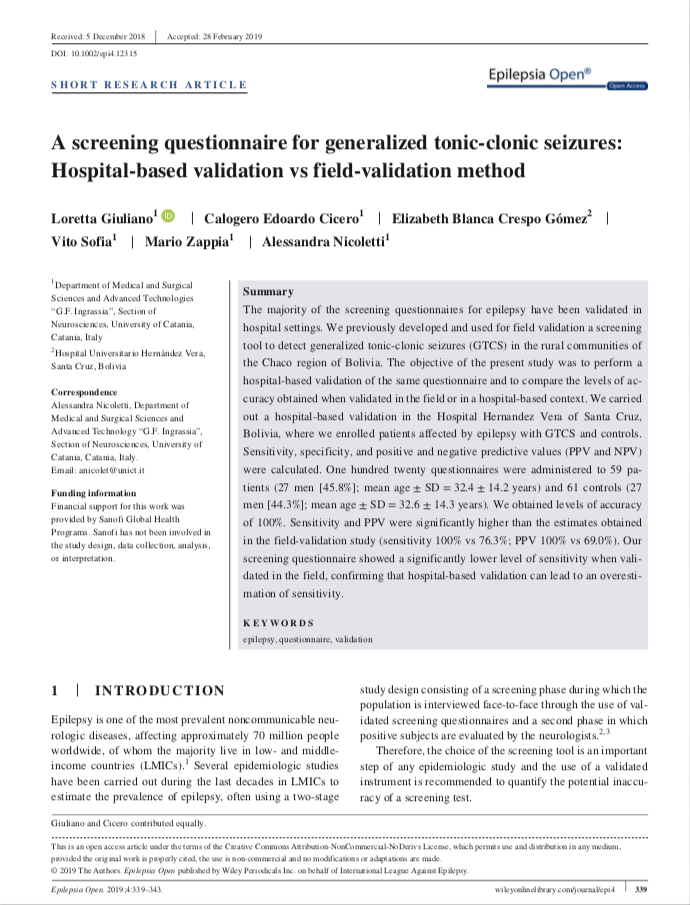 A screening questionnaire for convulsive seizures: A three-stage field-validation in rural Bolivia
A screening questionnaire for convulsive seizures: A three-stage field-validation in rural Bolivia Epilepsy is one of the most common neurological diseases in Latin American Countries (LAC) and epilepsy associated with convulsive seizures is the most frequent type. Therefore, the detection of convulsive seizures is a priority, but a validated Spanish-language screening tool to detect convulsive seizures is not available. We performed a field validation to evaluate the accuracy of a Spanish-language questionnaire to detect convulsive seizures in rural Bolivia using a three-stage design. The questionnaire was also administered face to- face, using a two-stage design, to evaluate the difference in accuracy. The study was carried out in the rural communities of the Gran Chaco region. The questionnaire consists of a single screening question directed toward the householders and a confirmatory section administered face-to-face to the index case. Positive subjects underwent a neurological examination to detect false positive and true positive subjects. To estimate the proportion of false negative, a random sample of about 20% of the screened negative underwent a neurological evaluation.
-
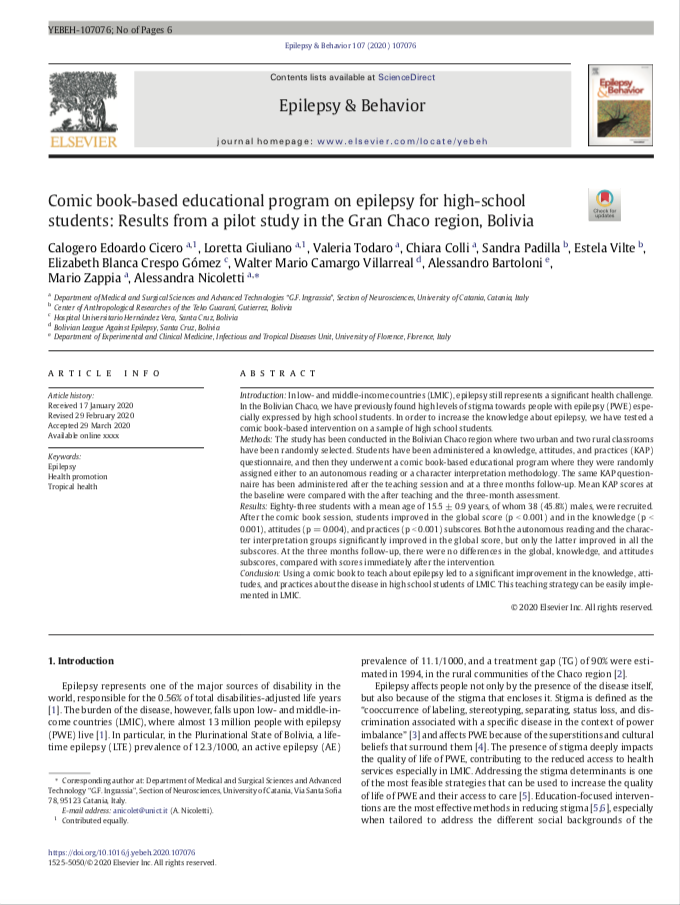 Comic book-based educational program on epilepsy for high-school students: Results from a pilot study in the Gran Chaco region, Bolivia
Comic book-based educational program on epilepsy for high-school students: Results from a pilot study in the Gran Chaco region, Bolivia In the Bolivian Chaco, we have previously found high levels of stigma towards people with epilepsy (PWE) especially
expressed by high school students. In order to increase the knowledge about epilepsy, we have tested a comic book-based intervention on a sample of high school students.
Methods: The study has been conducted in the Bolivian Chaco region where two urban and two rural classrooms
have been randomly selected. Students have been administered a knowledge, attitudes, and practices (KAP)
questionnaire, and then they underwent a comic book-based educational program where they were randomly
assigned either to an autonomous reading or a character interpretation methodology. The same KAP questionnaire
has been administered after the teaching session and at a three months follow-up. Mean KAP scores at the baseline were compared with the after teaching and the three-month assessment.
Results: Eighty-three students with a mean age of 15.5 ± 0.9 years, of whom 38 (45.8%) males, were recruited.
After the comic book session, students improved in the global score (p b 0.001) and in the knowledge (p b
0.001), attitudes (p=0.004), and practices (p b 0.001) subscores. Both the autonomous reading and the character
interpretation groups significantly improved in the global score, but only the latter improved in all the
subscores. At the three months follow-up, there were no differences in the global, knowledge, and attitudes
subscores, compared with scores immediately after the intervention.
Conclusion: Using a comic book to teach about epilepsy led to a significant improvement in the knowledge, attitudes,
and practices about the disease in high school students of LMIC. This teaching strategy can be easily implemented
in LMIC.
-
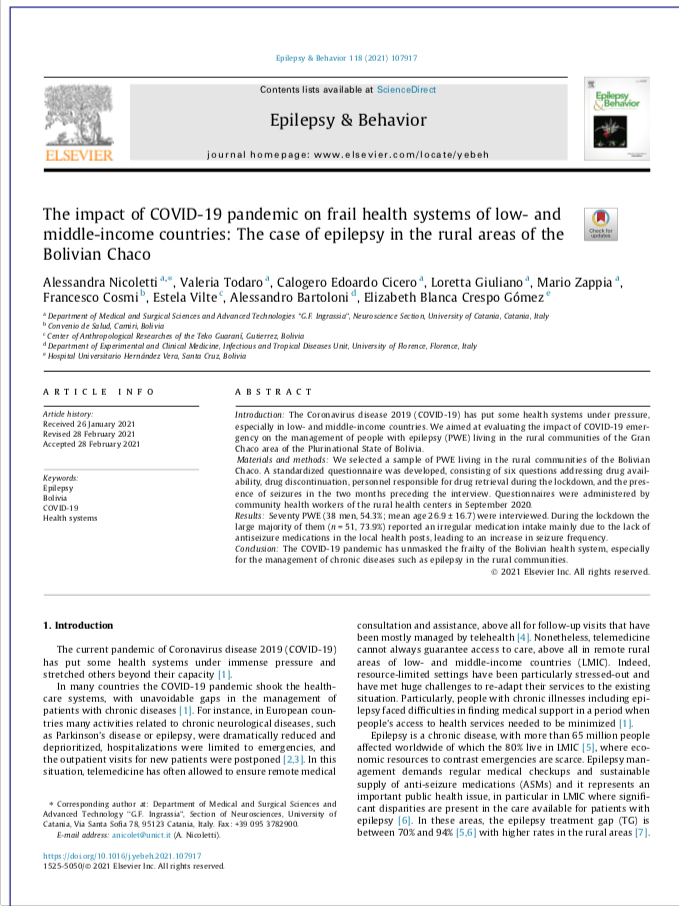 The impact of COVID-19 pandemic on frail health systems of low- and
middle-income countries: The case of epilepsy in the rural areas of the
Bolivian Chaco
The impact of COVID-19 pandemic on frail health systems of low- and
middle-income countries: The case of epilepsy in the rural areas of the
Bolivian Chaco
The Coronavirus disease 2019 (COVID-19) has put some health systems under pressure, especially in low- and middle-income countries. We aimed at evaluating the impact of COVID-19 emergency on the management of people with epilepsy (PWE) living in the rural communities of the Gran Chaco area of the Plurinational State of Bolivia. Materials and methods: We selected a sample of PWE living in the rural communities of the Bolivian Chaco. A standardized questionnaire was developed, consisting of six questions addressing drug availability,
drug discontinuation, personnel responsible for drug retrieval during the lockdown, and the presence of seizures in the two months preceding the interview. Questionnaires were administered by community health workers of the rural health centers in September 2020.
Results: Seventy PWE (38 men, 54.3%; mean age 26.9 ± 16.7) were interviewed. During the lockdown the large majority of them (n = 51, 73.9%) reported an irregular medication intake mainly due to the lack of antiseizure medications in the local health posts, leading to an increase in seizure frequency.
Conclusion: The COVID-19 pandemic has unmasked the frailty of the Bolivian health system, especially for the management of chronic diseases such as epilepsy in the rural communities.
-
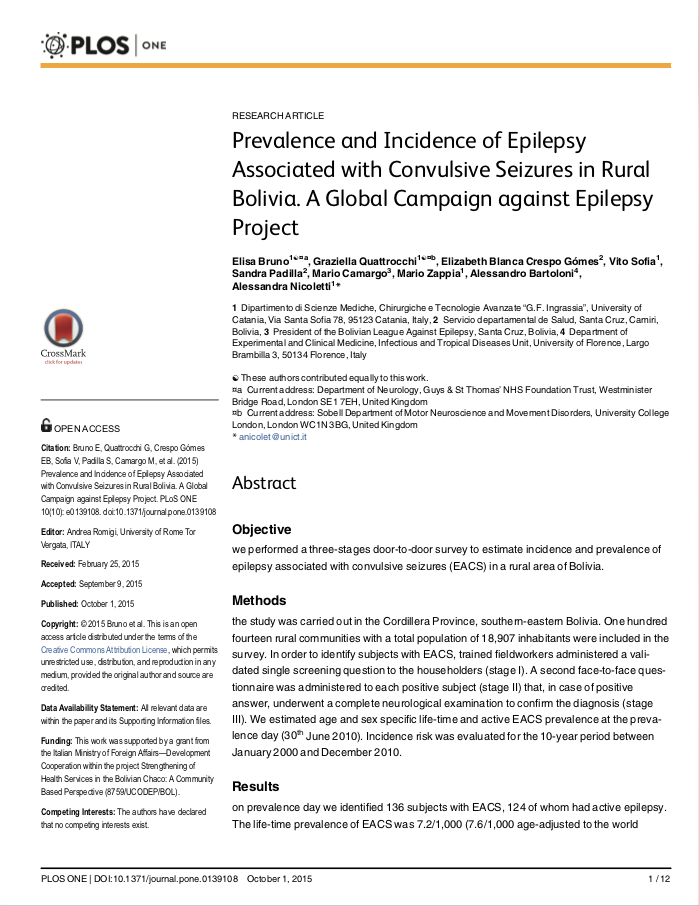 Prevalence and Incidence of Epilepsy Associated with Convulsive Seizures in Rural Bolivia. A Global Campaign against Epilepsy Project
Prevalence and Incidence of Epilepsy Associated with Convulsive Seizures in Rural Bolivia. A Global Campaign against Epilepsy Project The study was carried out in the Cordillera province, southern-eastern Bolivia. One hundred fourteen rural communities with a total population of 18.907 inhabitants were included in the survey. In order to identify subjects with EACS, trained fieldworkers administered a validate single screening question to the householders (stage I). A second face to face questionnaire was administered to each positive subject (stage II) that, in case of positive answer, underwent a complete neurological examination the diagnosis (stage III). We estimated age and sex specific life-time and active EACS prevalence at the prevalence day (30 june 2010). Incidence risk was evaluated for the 10 year period between January 2000 and December 2010
-
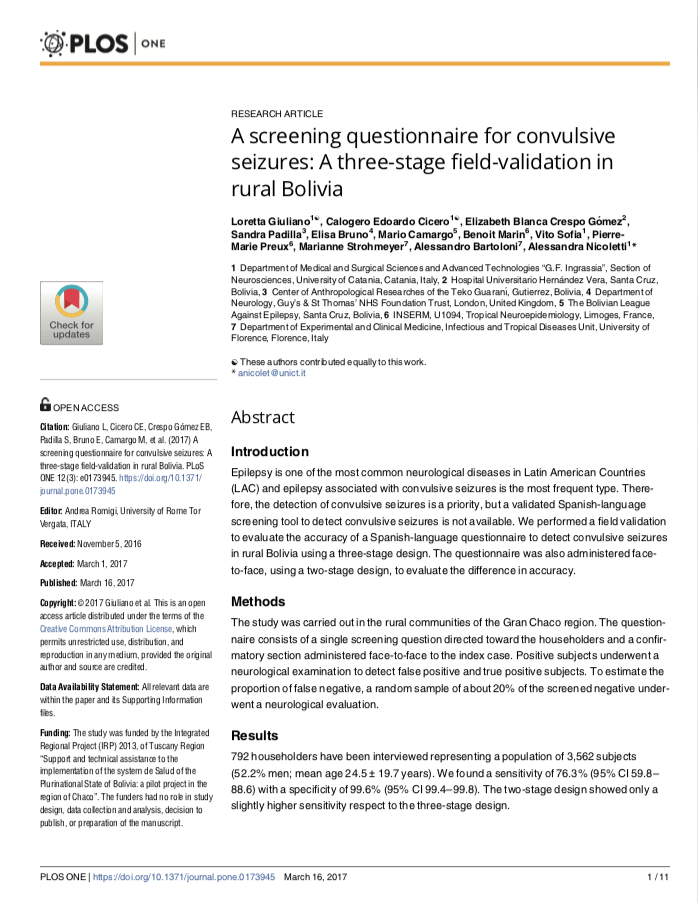 A screening questionnaire for generalized tonic-clonic
seizures: Hospital-based validation vs field-validation
method
A screening questionnaire for generalized tonic-clonic
seizures: Hospital-based validation vs field-validation
method
The majority of the screening questionnaires for epilepsy have been validated in
hospital settings. We previously developed and used for field validation a screening tool to detect generalized tonic-clonic seizures (GTCS) in the rural communities of the Chaco region of Bolivia. The objective of the present study was to perform a hospital-based validation of the same questionnaire and to compare the levels of accuracy obtained when validated in the field or in a hospital-based context. We carried out a hospital-based validation in the Hospital Hernandez Vera of Santa Cruz, Bolivia, where we enrolled patients affected by epilepsy with GTCS and controls. Sensitivity, specificity, and positive and negative predictive values (PPV and NPV) were calculated. One hundred twenty questionnaires were administered to 59 patients (27 men [45.8%]; mean age ± SD = 32.4 ± 14.2 years) and 61 controls (27 men [44.3%]; mean age ± SD = 32.6 ± 14.3 years). We obtained levels of accuracy of 100%. Sensitivity and PPV were significantly higher than the estimates obtained in the field-validation study (sensitivity 100% vs 76.3%; PPV 100% vs 69.0%). Our screening questionnaire showed a significantly lower level of sensitivity when validated in the field, confirming that hospital-based validation can lead to an overestimation of sensitivity.
-
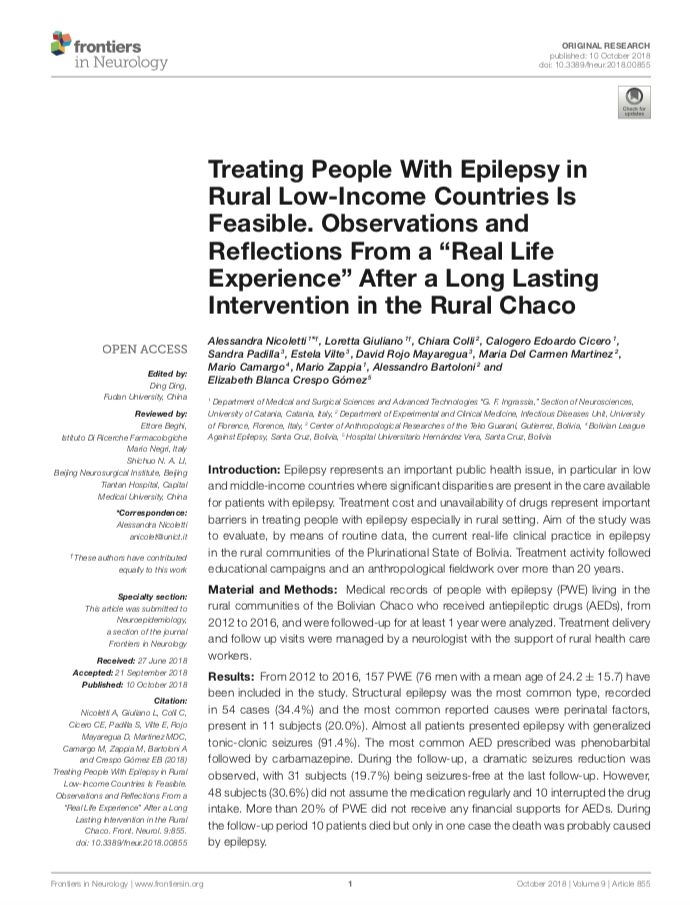 Treating People With Epilepsy in Rural Low-Income Countries Is
Feasible. Observations and Reflections From a “Real Life
Experience” After a Long Lasting Intervention in the Rural Chaco
Treating People With Epilepsy in Rural Low-Income Countries Is
Feasible. Observations and Reflections From a “Real Life
Experience” After a Long Lasting Intervention in the Rural Chaco
Epilepsy represents an important public health issue, in particular in low
andmiddle-income countries where significant disparities are present in the care available for patients with epilepsy. Treatment cost and unavailability of drugs represent important barriers in treating people with epilepsy especially in rural setting. Aim of the study was to evaluate, by means of routine data, the current real-life clinical practice in epilepsy in the rural communities of the Plurinational State of Bolivia. Treatment activity followed educational campaigns and an anthropological fieldwork over more than 20 years.
Material and Methods: Medical records of people with epilepsy (PWE) living in the rural communities of the Bolivian Chaco who received antiepileptic drugs (AEDs), from 2012 to 2016, and were followed-up for at least 1 year were analyzed. Treatment delivery and follow up visits were managed by a neurologist with the support of rural health care
workers.
Results: From 2012 to 2016, 157 PWE (76 men with a mean age of 24.2 ± 15.7) have been included in the study. Structural epilepsy was the most common type, recorded in 54 cases (34.4%) and the most common reported causes were perinatal factors, present in 11 subjects (20.0%). Almost all patients presented epilepsy with generalized tonic-clonic seizures (91.4%). The most common AED prescribed was phenobarbital followed by carbamazepine. During the follow-up, a dramatic seizures reduction was observed, with 31 subjects (19.7%) being seizures-free at the last follow-up. However, 48 subjects (30.6%) did not assume the medication regularly and 10 interrupted the drug intake. More than 20% of PWE did not receive any financial supports for AEDs. During the follow-up period 10 patients died but only in one case the death was probably caused by epilepsy. Our study monstrated that PWE in rural areas of the Bolivian Chaco are willing to seek medical attention and to receive antiepileptic treatment. However, improvement in care is needed to assure compliance to AED treatment, including activity to increase awareness toward epilepsy among community members and health staff of the rural communities and to guarantee the coverage of treatment costs and drug supply.
-
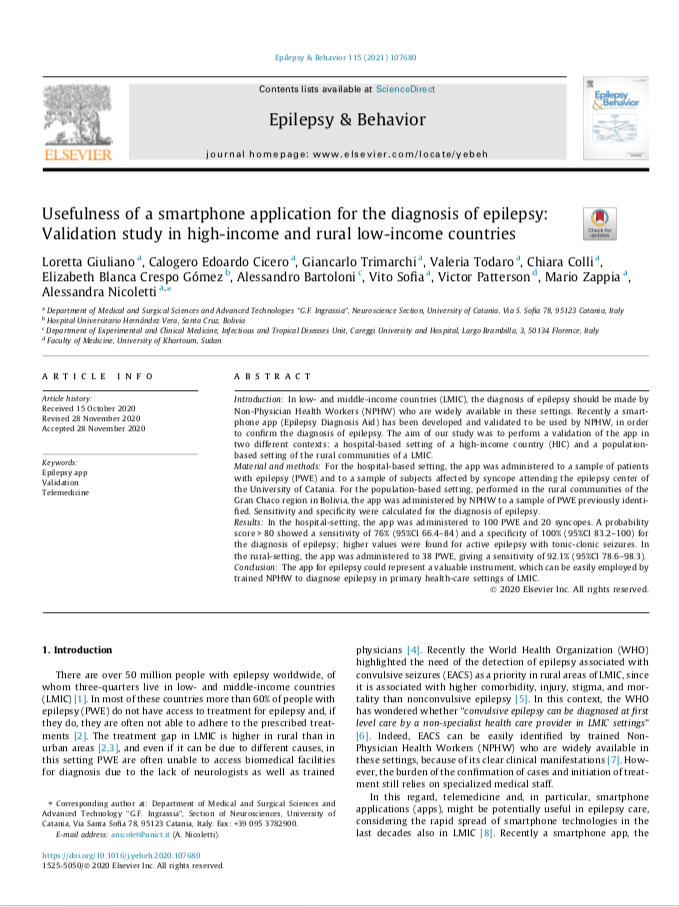 Usefulness of a smartphone application for the diagnosis of epilepsy: Validation study in high-income and rural low-income countries
Usefulness of a smartphone application for the diagnosis of epilepsy: Validation study in high-income and rural low-income countries In low- and middle-income countries (LMIC), the diagnosis of epilepsy should be made by Non-Physician Health Workers (NPHW) who are widely available in these settings. Recently a smartphone app (Epilepsy Diagnosis Aid) has been developed and validated to be used by NPHW, in order to confirm the diagnosis of epilepsy. The aim of our study was to perform a validation of the app in two different contexts: a hospital-based setting of a high-income country (HIC) and a population based setting of the rural communities of a LMIC.
Material and methods: For the hospital-based setting, the app was administered to a sample of patients with epilepsy (PWE) and to a sample of subjects affected by syncope attending the epilepsy center of the University of Catania. For the population-based setting, performed in the rural communities of the Gran Chaco region in Bolivia, the app was administered by NPHW to a sample of PWE previously identified. Sensitivity and specificity were calculated for the diagnosis of epilepsy.
Results: In the hospital-setting, the app was administered to 100 PWE and 20 syncopes. A probability score > 80 showed a sensitivity of 76% (95%CI 66.4–84) and a specificity of 100% (95%CI 83.2–100) for the diagnosis of epilepsy; higher values were found for active epilepsy with tonic-clonic seizures. In the rural-setting, the app was administered to 38 PWE, giving a sensitivity of 92.1% (95%CI 78.6–98.3).
Conclusion: The app for epilepsy could represent a valuable instrument, which can be easily employed by trained NPHW to diagnose epilepsy in primary health-care settings of LMIC
 Análisis de la alimentación escolar al interior de las unidades educativas en el Municipio de Santa Cruz de la Sierra durante la gestión 2024. Este trabajo de investigación tiene como objetivo realizar un análisis exhaustivo sobre la alimentación en las unidades educativas del municipio de Santa Cruz durante la gestión 2024. En un contexto donde la nutrición infantil es fundamental para el desarrollo físico y cognitivo de los estudiantes, la Unidad de Alimentación y Nutrición del Ministerio de Salud ha subrayado la importancia de priorizar una alimentación saludable en niños y niñas en edad escolar, específicamente en el grupo etario de 9 a 12 años. Esta etapa de crecimiento y desarrollo se caracteriza por cambios físicos significativos, y es crucial asegurar que se satisfagan los requerimientos nutricionales de los menores. El informe presentado por la Organización Panamericana de la Salud (OPS) y la Organización Mundial de la Salud (OMS) destaca una problemática alarmante en Bolivia: la prevalencia total de sobrepeso y obesidad en escolares de entre 5 y 18 años ha superado el 35,6%. Este dato pone de manifiesto una crisis de salud pública, ya que la obesidad infantil se asocia con una serie de patologías graves, incluyendo hipertensión, diabetes y alteraciones en los niveles lipídicos. Estas condiciones, que pueden manifestarse desde la niñez, aumentan el riesgo cardiovascular a lo largo de la vida, haciendo imprescindible la implementación de estrategias para contrarrestar esta tendencia. Con base en esta problemática, se llevará a cabo un análisis que incluirá la implementación de snacks saludables en las unidades educativas del municipio. Esta estrategia no solo busca mejorar la calidad nutricional de las meriendas consumidas por los estudiantes, sino también promover un cambio en los hábitos alimenticios. Para complementar esta iniciativa, se realizarán talleres, dinámicas y charlas educativas dirigidas tanto a los estudiantes como a los padres de familia.
Análisis de la alimentación escolar al interior de las unidades educativas en el Municipio de Santa Cruz de la Sierra durante la gestión 2024. Este trabajo de investigación tiene como objetivo realizar un análisis exhaustivo sobre la alimentación en las unidades educativas del municipio de Santa Cruz durante la gestión 2024. En un contexto donde la nutrición infantil es fundamental para el desarrollo físico y cognitivo de los estudiantes, la Unidad de Alimentación y Nutrición del Ministerio de Salud ha subrayado la importancia de priorizar una alimentación saludable en niños y niñas en edad escolar, específicamente en el grupo etario de 9 a 12 años. Esta etapa de crecimiento y desarrollo se caracteriza por cambios físicos significativos, y es crucial asegurar que se satisfagan los requerimientos nutricionales de los menores. El informe presentado por la Organización Panamericana de la Salud (OPS) y la Organización Mundial de la Salud (OMS) destaca una problemática alarmante en Bolivia: la prevalencia total de sobrepeso y obesidad en escolares de entre 5 y 18 años ha superado el 35,6%. Este dato pone de manifiesto una crisis de salud pública, ya que la obesidad infantil se asocia con una serie de patologías graves, incluyendo hipertensión, diabetes y alteraciones en los niveles lipídicos. Estas condiciones, que pueden manifestarse desde la niñez, aumentan el riesgo cardiovascular a lo largo de la vida, haciendo imprescindible la implementación de estrategias para contrarrestar esta tendencia. Con base en esta problemática, se llevará a cabo un análisis que incluirá la implementación de snacks saludables en las unidades educativas del municipio. Esta estrategia no solo busca mejorar la calidad nutricional de las meriendas consumidas por los estudiantes, sino también promover un cambio en los hábitos alimenticios. Para complementar esta iniciativa, se realizarán talleres, dinámicas y charlas educativas dirigidas tanto a los estudiantes como a los padres de familia. Estreñimiento funcional, relacionado con la ingesta diaria de fibra dietética soluble e insoluble, líquidos y actividad física en la población de 20 a 59 años de edad que acude al servicio de consulta externa de nutrición del Seguro Integral de Salud SINEC. Este trabajo de investigación tiene como objetivo determinar el principal factor de riesgo para el estreñimiento funcional, cuantificando la ingesta diaria de fibra dietética soluble e insoluble, líquidos y actividad física en la población de 20 a 59 años de edad que acude al servicio de consulta externa de Nutrición del Seguro Integral de salud SINEC en la gestión 2023 La constipación o estreñimiento, es un problema común con una prevalencia del 2 al 27% de la población mundial, incluida Latinoamérica. Montalvo (2013), en un artículo sobre sostiene que la situación en Latinoamérica es muy preocupante, ya que muestra porcentajes elevados de estreñimiento crónico y las personas que los padecen el 75% utilizan algún tipo de medicación, el 27% se auto medican, el 50% utilizan medicamentos caseros y solo el 38% de personas consumen fibra. El presente estudio tiene un enfoque cuantitativo, correlacional, descriptivo de asociación cruzada y transversal, debido a que se medirá el grado de relación que existe entre las variables, las cuales no se manipulan ni controlan los datos, sobre una determinada población de muestra, recopiladas en un periodo de tiempo. Según el tipo de heces evacuadas, medida a través de la escala de Bristol, observamos que en la población de estudio el 19, 4% y 1,4% presenta el tipo 2 y tipo 1 respectivamente el cual representa a heces duras, y transito lento (constipación), de 144 pacientes encuestados, 30 (20,83%) de la población presenta estreñimiento funcional en los cuales se basó el estudio, para establecer los factores de riesgo. Según los datos de riesgo, los pacientes con estreñimiento funcional, cuya ingesta de Fibra dietética es inferior a la necesaria, tienen 2,5 veces más probabilidad de presentar el padecimiento y los sedentarios 2,22 veces, en cuestión a la ingesta de líquidos, es un factor de riesgo incluso aún mayor, ya que existe 3,35 veces mayor probabilidad de presentar estreñimiento. Sin embargo lo más destacable, es la variable proporción del tipo de fibra soluble e insoluble, ya que con proporciones inadecuadas existe 22,25 veces mayor probabilidad de presentar estreñimiento funcional, por lo tanto, constituye el principal factor de riesgo de este estudio.
Estreñimiento funcional, relacionado con la ingesta diaria de fibra dietética soluble e insoluble, líquidos y actividad física en la población de 20 a 59 años de edad que acude al servicio de consulta externa de nutrición del Seguro Integral de Salud SINEC. Este trabajo de investigación tiene como objetivo determinar el principal factor de riesgo para el estreñimiento funcional, cuantificando la ingesta diaria de fibra dietética soluble e insoluble, líquidos y actividad física en la población de 20 a 59 años de edad que acude al servicio de consulta externa de Nutrición del Seguro Integral de salud SINEC en la gestión 2023 La constipación o estreñimiento, es un problema común con una prevalencia del 2 al 27% de la población mundial, incluida Latinoamérica. Montalvo (2013), en un artículo sobre sostiene que la situación en Latinoamérica es muy preocupante, ya que muestra porcentajes elevados de estreñimiento crónico y las personas que los padecen el 75% utilizan algún tipo de medicación, el 27% se auto medican, el 50% utilizan medicamentos caseros y solo el 38% de personas consumen fibra. El presente estudio tiene un enfoque cuantitativo, correlacional, descriptivo de asociación cruzada y transversal, debido a que se medirá el grado de relación que existe entre las variables, las cuales no se manipulan ni controlan los datos, sobre una determinada población de muestra, recopiladas en un periodo de tiempo. Según el tipo de heces evacuadas, medida a través de la escala de Bristol, observamos que en la población de estudio el 19, 4% y 1,4% presenta el tipo 2 y tipo 1 respectivamente el cual representa a heces duras, y transito lento (constipación), de 144 pacientes encuestados, 30 (20,83%) de la población presenta estreñimiento funcional en los cuales se basó el estudio, para establecer los factores de riesgo. Según los datos de riesgo, los pacientes con estreñimiento funcional, cuya ingesta de Fibra dietética es inferior a la necesaria, tienen 2,5 veces más probabilidad de presentar el padecimiento y los sedentarios 2,22 veces, en cuestión a la ingesta de líquidos, es un factor de riesgo incluso aún mayor, ya que existe 3,35 veces mayor probabilidad de presentar estreñimiento. Sin embargo lo más destacable, es la variable proporción del tipo de fibra soluble e insoluble, ya que con proporciones inadecuadas existe 22,25 veces mayor probabilidad de presentar estreñimiento funcional, por lo tanto, constituye el principal factor de riesgo de este estudio. Conocimientos, actitudes y prácticas sobre el consumo de sal añadida y la presencia de sodio en los alimentos relacionados a la presencia de hipertensión arterial en adultos mayores de 50 a 70 años realizado en el centro para adultos mayores y personas con discapacidad del distrito 11 La presente investigación analiza los conocimientos, actitudes y prácticas (CAP) sobre el consumo de sal añadida y la presencia de sodio en los alimentos, y su relación con la hipertensión arterial en adultos mayores de 50 a 60 años. El objetivo principal es identificar los patrones de comportamiento y niveles de conciencia en este grupo demográfico sobre los riesgos asociados al consumo elevado de sodio, un factor clave en el desarrollo de la hipertensión. Este estudio abarca una evaluación del nivel de conocimiento de los participantes, enfocándose en los efectos del sodio en la salud. También incluye la identificación de las fuentes alimentarias que contienen sodio en exceso, como los alimentos procesados, embutidos, conservas y comidas rápidas, que son de consumo frecuente en muchos casos. Se analiza la relación directa entre la ingesta elevada de sal y la aparición de hipertensión arterial, lo que permite comprender cómo las elecciones alimentarias y el uso frecuente de sal influyen directamente en el desarrollo de esta enfermedad. Además de este enfoque principal, el estudio toma en cuenta otros factores que podrían potenciar los efectos del consumo elevado de sodio, como la edad, el género y el nivel educativo de los participantes. Estos factores permiten obtener una perspectiva más completa sobre cómo varía la influencia del sodio en distintas personas. Por otro lado, la investigación revisa las recomendaciones diarias de consumo de sodio y cómo estas se comparan con las prácticas actuales de los participantes, lo que contribuye a identificar las posibles brechas entre el conocimiento y la aplicación de hábitos saludables. Así mismo, se analizarán sus actitudes hacia la reducción del sodio en la dieta, además se identificarán las prácticas alimentarias cotidianas relacionadas con el uso de sal y el consumo de alimentos procesados ricos en sodio. Esto permitirá comprender las barreras y facilitadores para la adopción de hábitos alimenticios más saludables en esta etapa de la vida. La investigación busca no solo identificar factores que incrementan el riesgo de hipertensión, sino también examinar las brechas en el conocimiento y la aplicación de medidas preventivas. Además, se consideran los factores culturales que pueden influir en los hábitos alimentarios de este grupo demográfico. Finalmente, se proponen recomendaciones prácticas y específicas para el diseño de intervenciones educativas, enfocadas en mejorar
Conocimientos, actitudes y prácticas sobre el consumo de sal añadida y la presencia de sodio en los alimentos relacionados a la presencia de hipertensión arterial en adultos mayores de 50 a 70 años realizado en el centro para adultos mayores y personas con discapacidad del distrito 11 La presente investigación analiza los conocimientos, actitudes y prácticas (CAP) sobre el consumo de sal añadida y la presencia de sodio en los alimentos, y su relación con la hipertensión arterial en adultos mayores de 50 a 60 años. El objetivo principal es identificar los patrones de comportamiento y niveles de conciencia en este grupo demográfico sobre los riesgos asociados al consumo elevado de sodio, un factor clave en el desarrollo de la hipertensión. Este estudio abarca una evaluación del nivel de conocimiento de los participantes, enfocándose en los efectos del sodio en la salud. También incluye la identificación de las fuentes alimentarias que contienen sodio en exceso, como los alimentos procesados, embutidos, conservas y comidas rápidas, que son de consumo frecuente en muchos casos. Se analiza la relación directa entre la ingesta elevada de sal y la aparición de hipertensión arterial, lo que permite comprender cómo las elecciones alimentarias y el uso frecuente de sal influyen directamente en el desarrollo de esta enfermedad. Además de este enfoque principal, el estudio toma en cuenta otros factores que podrían potenciar los efectos del consumo elevado de sodio, como la edad, el género y el nivel educativo de los participantes. Estos factores permiten obtener una perspectiva más completa sobre cómo varía la influencia del sodio en distintas personas. Por otro lado, la investigación revisa las recomendaciones diarias de consumo de sodio y cómo estas se comparan con las prácticas actuales de los participantes, lo que contribuye a identificar las posibles brechas entre el conocimiento y la aplicación de hábitos saludables. Así mismo, se analizarán sus actitudes hacia la reducción del sodio en la dieta, además se identificarán las prácticas alimentarias cotidianas relacionadas con el uso de sal y el consumo de alimentos procesados ricos en sodio. Esto permitirá comprender las barreras y facilitadores para la adopción de hábitos alimenticios más saludables en esta etapa de la vida. La investigación busca no solo identificar factores que incrementan el riesgo de hipertensión, sino también examinar las brechas en el conocimiento y la aplicación de medidas preventivas. Además, se consideran los factores culturales que pueden influir en los hábitos alimentarios de este grupo demográfico. Finalmente, se proponen recomendaciones prácticas y específicas para el diseño de intervenciones educativas, enfocadas en mejorar Efecto del consumo de 3 gramos/día de omega-3 sobre los niveles de presión arterial relacionados con el seguimiento anamnésico prospectivo, en pacientes hipertensos del Hospital San Juan de Dios. La hipertensión arterial es una enfermedad crónica no transmisible caracterizada por el aumento persistente de la presión sanguínea en las arterias. En Bolivia, afecta a 6,904 personas por cada 100,000 habitantes, con una prevalencia del 18% entre adultos de 25 a 60 años en ciertas regiones. Esta condición representa un importante factor de riesgo para enfermedades cardiovasculares, diabetes, síndrome metabólico y enfermedad renal. Medidas preventivas efectivas incluyen la reducción del consumo de sal, la adopción de una dieta rica en frutas y verduras, la práctica regular de actividad física, el mantenimiento de un peso saludable y el cumplimiento del tratamiento médico. La implementación de estas estrategias no solo ayuda a controlar la hipertensión, sino que también previene complicaciones asociadas como infartos de miocardio y accidentes cerebrovasculares, mejorando así los resultados de salud pública. Los ácidos grasos omega-3 son una forma de grasa poliinsaturada que el cuerpo obtiene de los alimentos. El Omega-3 es conocido como ácidos grasos esenciales debido a que el cuerpo no puede producirlos por sí solo, de tal manera que los debe obtener de los alimentos o mediante suplementación para lograr cubrir los requerimientos y que así cumplan su función en nuestro cuerpo con múltiples beneficios. El objetivo de este estudio es suplementar con ácidos grasos 3 gramos/día de omega-3 a la población con hipertensión y determinar el efecto que esta tiene sobre los niveles de presión arterial, acompañado también de seguimiento nutricional mediante anamnesis alimentaria y toma de talla/peso y de la presión arterial a los pacientes del grupo de estudio. El estudio se realizó en el hospital San Juan de Dios en el departamento de Santa Cruz, Bolivia; donde el grupo de estudio estaba conformado por 60 pacientes hipertensos de rango de edad entre 30 a 60 años. Donde 30 pacientes son de grupo experimental y 30 de grupo control. En el grupo experimental que recibió 3 gramos diarios de omega-3, se observaron mejoras significativas en los niveles de presión arterial sistólica a lo largo del estudio, con notables aumentos en la categoría de presión normal y reducciones en las categorías de presión alta y crisis hipertensiva. En contraste, el grupo control mostró mejoras menos marcadas. Respecto a la presión arterial diastólica, el grupo experimental también experimentó mejoras notables, especialmente en la normalización de la presión y reducciones en los niveles más altos de presión. Estos hallazgos sugieren
Efecto del consumo de 3 gramos/día de omega-3 sobre los niveles de presión arterial relacionados con el seguimiento anamnésico prospectivo, en pacientes hipertensos del Hospital San Juan de Dios. La hipertensión arterial es una enfermedad crónica no transmisible caracterizada por el aumento persistente de la presión sanguínea en las arterias. En Bolivia, afecta a 6,904 personas por cada 100,000 habitantes, con una prevalencia del 18% entre adultos de 25 a 60 años en ciertas regiones. Esta condición representa un importante factor de riesgo para enfermedades cardiovasculares, diabetes, síndrome metabólico y enfermedad renal. Medidas preventivas efectivas incluyen la reducción del consumo de sal, la adopción de una dieta rica en frutas y verduras, la práctica regular de actividad física, el mantenimiento de un peso saludable y el cumplimiento del tratamiento médico. La implementación de estas estrategias no solo ayuda a controlar la hipertensión, sino que también previene complicaciones asociadas como infartos de miocardio y accidentes cerebrovasculares, mejorando así los resultados de salud pública. Los ácidos grasos omega-3 son una forma de grasa poliinsaturada que el cuerpo obtiene de los alimentos. El Omega-3 es conocido como ácidos grasos esenciales debido a que el cuerpo no puede producirlos por sí solo, de tal manera que los debe obtener de los alimentos o mediante suplementación para lograr cubrir los requerimientos y que así cumplan su función en nuestro cuerpo con múltiples beneficios. El objetivo de este estudio es suplementar con ácidos grasos 3 gramos/día de omega-3 a la población con hipertensión y determinar el efecto que esta tiene sobre los niveles de presión arterial, acompañado también de seguimiento nutricional mediante anamnesis alimentaria y toma de talla/peso y de la presión arterial a los pacientes del grupo de estudio. El estudio se realizó en el hospital San Juan de Dios en el departamento de Santa Cruz, Bolivia; donde el grupo de estudio estaba conformado por 60 pacientes hipertensos de rango de edad entre 30 a 60 años. Donde 30 pacientes son de grupo experimental y 30 de grupo control. En el grupo experimental que recibió 3 gramos diarios de omega-3, se observaron mejoras significativas en los niveles de presión arterial sistólica a lo largo del estudio, con notables aumentos en la categoría de presión normal y reducciones en las categorías de presión alta y crisis hipertensiva. En contraste, el grupo control mostró mejoras menos marcadas. Respecto a la presión arterial diastólica, el grupo experimental también experimentó mejoras notables, especialmente en la normalización de la presión y reducciones en los niveles más altos de presión. Estos hallazgos sugieren Validez diagnóstica de la circunferencia cervical como variable antropométrica fiable y asociativa mediante la proposición de puntos de corte sensibles y específicos en la malnutrición por exceso en niños y adolescentes entre 8 y 17 años en la Ciudad de Santa Cruz de la Sierra, Bolivia. Para el diagnóstico de la obesidad, uno de los indicadores tradicionales y más útiles es el Índice de masa corporal (IMC), recomendado por varios comités tanto para los adultos como para niños y adolescentes. Sin embargo, esta tiene sus limitaciones y puede clasificar de forma errónea debido a la presencia de factores como: desarrollo muscular, tamaño del cráneo, un torso prominente, entre otros. De tal forma, que se convierte en no-viable a la hora de determinar volumen de la masa grasa En este entendido, el objetivo del presente trabajo yace en la exploración de la validez diagnóstica de la circunferencia cervical como variable antropométrica asociativa de diagnóstico de la malnutrición por exceso (sobrepeso, obesidad, obesidad severa). El enfoque del presente estudio es de tipo cuantitativo, descriptivo – explicativo, de campo, de carácter prospectivo y transversal entre los meses de septiembre y noviembre de 2023. El levantamiento de datos involucró la medición de 1365 estudiantes de los diferentes colegios del municipio de Santa Cruz de la Sierra, los sujetos de la muestra rondan entre los 8 a 17 años y un rango de talla que oscila entre 120 a 180 centímetros. La distribución de la prevalencia de la malnutrición por exceso, el cual es una variable combinatoria de sobrepeso, obesidad y obesidad severa según género muestra que el grupo más afectado son los estudiantes varones, que tienen una tasa de malnutrición del 46,5%, frente al 41,1% de prevalencia en las estudiantes mujeres. Asimismo, Se pusieron bajo la lupa a tres variables: circunferencia cervical (Ccu), circunferencia de la cintura (Cci) o abdominal, y el IMC. La correlación entre el Ccu (r = 0,627 para niñas, y r=0,631 para niños) y el IMC es ligeramente menor a la correlación del Cci con el IMC (r=0,778 para niñas y r=0,787 para niños). Esto se puede interpretar que hay una mejor sinergia entre el Cci y el IMC, sin embargo, también hay que destacar la correlación entre el Ccu y el Cci, el cual también tiene una alta fuerza correlativa-asociativa (r=0,747 para niñas y r=0,764 para niños. Una vez, establecida la validez diagnóstica moderada, se procedió a realizar los correspondientes cálculos de sensibilidad y especificad con el propósito de establecer propuestas de puntos de corte de normalidad para cada rango-edad y rango-talla obtenidos a través del método estadístico de Curvas ROC y razones de verosimilitud positiva y negativa.
Validez diagnóstica de la circunferencia cervical como variable antropométrica fiable y asociativa mediante la proposición de puntos de corte sensibles y específicos en la malnutrición por exceso en niños y adolescentes entre 8 y 17 años en la Ciudad de Santa Cruz de la Sierra, Bolivia. Para el diagnóstico de la obesidad, uno de los indicadores tradicionales y más útiles es el Índice de masa corporal (IMC), recomendado por varios comités tanto para los adultos como para niños y adolescentes. Sin embargo, esta tiene sus limitaciones y puede clasificar de forma errónea debido a la presencia de factores como: desarrollo muscular, tamaño del cráneo, un torso prominente, entre otros. De tal forma, que se convierte en no-viable a la hora de determinar volumen de la masa grasa En este entendido, el objetivo del presente trabajo yace en la exploración de la validez diagnóstica de la circunferencia cervical como variable antropométrica asociativa de diagnóstico de la malnutrición por exceso (sobrepeso, obesidad, obesidad severa). El enfoque del presente estudio es de tipo cuantitativo, descriptivo – explicativo, de campo, de carácter prospectivo y transversal entre los meses de septiembre y noviembre de 2023. El levantamiento de datos involucró la medición de 1365 estudiantes de los diferentes colegios del municipio de Santa Cruz de la Sierra, los sujetos de la muestra rondan entre los 8 a 17 años y un rango de talla que oscila entre 120 a 180 centímetros. La distribución de la prevalencia de la malnutrición por exceso, el cual es una variable combinatoria de sobrepeso, obesidad y obesidad severa según género muestra que el grupo más afectado son los estudiantes varones, que tienen una tasa de malnutrición del 46,5%, frente al 41,1% de prevalencia en las estudiantes mujeres. Asimismo, Se pusieron bajo la lupa a tres variables: circunferencia cervical (Ccu), circunferencia de la cintura (Cci) o abdominal, y el IMC. La correlación entre el Ccu (r = 0,627 para niñas, y r=0,631 para niños) y el IMC es ligeramente menor a la correlación del Cci con el IMC (r=0,778 para niñas y r=0,787 para niños). Esto se puede interpretar que hay una mejor sinergia entre el Cci y el IMC, sin embargo, también hay que destacar la correlación entre el Ccu y el Cci, el cual también tiene una alta fuerza correlativa-asociativa (r=0,747 para niñas y r=0,764 para niños. Una vez, establecida la validez diagnóstica moderada, se procedió a realizar los correspondientes cálculos de sensibilidad y especificad con el propósito de establecer propuestas de puntos de corte de normalidad para cada rango-edad y rango-talla obtenidos a través del método estadístico de Curvas ROC y razones de verosimilitud positiva y negativa. Relación entre el síndrome del estrés laboral asistencial y los hábitos alimenticios en trabajadores menores de 55 años, en el Hospital Municipal Francés La alimentación junto con los factores psicológicos son temas de suma importancia en un trabajador, por lo que los hábitos alimenticios afectan el desarrollo en la persona afectando la salud tanto nutricional como psicológica, de igual manera que el estrés laboral puede presentar signos y síntomas preocupantes en la persona que llegan a afectar el organismo de distinta forma. Por este motivo es que la presente investigación se llevó a cabo con el objetivo de identificar la relación que existe entre el síndrome de estrés laboral asistencial y los hábitos alimenticios en trabajadores. La investigación presenta un enfoque cuantitativo de tipo no experimental con diseño transversal. La investigación se realizó mediante el Test Burnout de Maslach para identificar el Síndrome de estrés laboral asistencial (Síndrome de Burnout), el Índice de Alimentación Saludable se utilizó para identificar los hábitos alimenticios, utilizando el cuestionario de Willet y el test de Block desarrollados en la investigación de un estudio en Uruguay, cambiando los grupos alimenticios de acuerdo a la guía alimentaria boliviana. Se consideró un muestreo no probabilístico por conveniencia, obteniendo una población con cuatrocientas personas aproximadamente, alcanzando una muestra de 277 personas en el Hospital Municipal Francés, donde se encuestó durante el mes de septiembre y octubre, realizando también una actividad extra en la institución. Se trabajó la base de datos en los Software SPSS y Excel para obtener resultados concisos, donde se consideró mayor porcentaje en mujeres que hombres con poca diferencia, tomado en cuenta como variable interviniente, además de peso, talla, edad, estado civil, tiempo en su trabajo actual, cargo laboral, situación laboral. Si bien los resultados entre estrés laboral asistencial (Burnout) y el Índice de Alimentación Saludable (IAS), se evidenció una relación muy débil, aunque positiva con Cansancio Emocional y Realización Personal, también se demostró la presencia de estrés laboral asistencial en más de la mitad de la muestra encuestada, explicando conforme se encuestaba los riesgos, factores del estrés laboral y lo que se considera una buena alimentación.
Relación entre el síndrome del estrés laboral asistencial y los hábitos alimenticios en trabajadores menores de 55 años, en el Hospital Municipal Francés La alimentación junto con los factores psicológicos son temas de suma importancia en un trabajador, por lo que los hábitos alimenticios afectan el desarrollo en la persona afectando la salud tanto nutricional como psicológica, de igual manera que el estrés laboral puede presentar signos y síntomas preocupantes en la persona que llegan a afectar el organismo de distinta forma. Por este motivo es que la presente investigación se llevó a cabo con el objetivo de identificar la relación que existe entre el síndrome de estrés laboral asistencial y los hábitos alimenticios en trabajadores. La investigación presenta un enfoque cuantitativo de tipo no experimental con diseño transversal. La investigación se realizó mediante el Test Burnout de Maslach para identificar el Síndrome de estrés laboral asistencial (Síndrome de Burnout), el Índice de Alimentación Saludable se utilizó para identificar los hábitos alimenticios, utilizando el cuestionario de Willet y el test de Block desarrollados en la investigación de un estudio en Uruguay, cambiando los grupos alimenticios de acuerdo a la guía alimentaria boliviana. Se consideró un muestreo no probabilístico por conveniencia, obteniendo una población con cuatrocientas personas aproximadamente, alcanzando una muestra de 277 personas en el Hospital Municipal Francés, donde se encuestó durante el mes de septiembre y octubre, realizando también una actividad extra en la institución. Se trabajó la base de datos en los Software SPSS y Excel para obtener resultados concisos, donde se consideró mayor porcentaje en mujeres que hombres con poca diferencia, tomado en cuenta como variable interviniente, además de peso, talla, edad, estado civil, tiempo en su trabajo actual, cargo laboral, situación laboral. Si bien los resultados entre estrés laboral asistencial (Burnout) y el Índice de Alimentación Saludable (IAS), se evidenció una relación muy débil, aunque positiva con Cansancio Emocional y Realización Personal, también se demostró la presencia de estrés laboral asistencial en más de la mitad de la muestra encuestada, explicando conforme se encuestaba los riesgos, factores del estrés laboral y lo que se considera una buena alimentación. Estrategias para capacitar a las madres sobre el cuidado del niño prematuro en el hogar con base al programa madre canguro servicio de neonatología Hospital Universitario Japonés, enero – junio 2016 La presente investigación sobre estrategias para capacitar a las madres en el cuidado del niño prematuro en el hogar, con base al Programa Madre Canguro, fue realizado en el servicio de Neonatología del Hospital Universitario Japonés durante el periodo de enero a junio del 2016, con el objetivo de proponer un modelo de capacitación a las madres con base al Programa Madre Canguro para la prevención de las complicaciones del prematuro en el hogar. La metodología es de tipo descriptivo, analítico y cuantitativo, cuyo universo estuvo compuesto por todas las madres de los niños prematuros que ingresaron al servicio de Neonatología del Hospital, se aplicó un test con preguntas cerradas relacionadas con todas las variables de la investigación. Los resultados obtenidos fueron: 58% de los niños prematuros corresponden a prematuro moderado o tardío, 64% de los prematuros desarrollaron ictericia del prematuro, 35% de los niños prematuros tienen una madre de 15 años, 30% de las madres alcanzaron a estudiar solo la primaria. El 50% de las madres viven en unión libre, el 40% de las mamas tienen más de 6 hijos, el 35% se dedican al comercio, el 33% de los prematuros que volvieron como reingreso al hospital fue por hipotermia. Se concluye mencionando que la edad de la madre influye en el nacimiento de los niños prematuros, los diagnósticos más frecuentes fueron la ictericia, apnea e hipoglicemia. Las causas de reingresos fueron la hipotermia, neumonía, desnutrición y deshidratación, factores que están relacionados con la calidad del cuidado que brinda la madre en el hogar. Capacitando a las madres sobre los cuidados del prematuro en el hogar se disminuirán los reingresos por complicaciones en los hospitales
Estrategias para capacitar a las madres sobre el cuidado del niño prematuro en el hogar con base al programa madre canguro servicio de neonatología Hospital Universitario Japonés, enero – junio 2016 La presente investigación sobre estrategias para capacitar a las madres en el cuidado del niño prematuro en el hogar, con base al Programa Madre Canguro, fue realizado en el servicio de Neonatología del Hospital Universitario Japonés durante el periodo de enero a junio del 2016, con el objetivo de proponer un modelo de capacitación a las madres con base al Programa Madre Canguro para la prevención de las complicaciones del prematuro en el hogar. La metodología es de tipo descriptivo, analítico y cuantitativo, cuyo universo estuvo compuesto por todas las madres de los niños prematuros que ingresaron al servicio de Neonatología del Hospital, se aplicó un test con preguntas cerradas relacionadas con todas las variables de la investigación. Los resultados obtenidos fueron: 58% de los niños prematuros corresponden a prematuro moderado o tardío, 64% de los prematuros desarrollaron ictericia del prematuro, 35% de los niños prematuros tienen una madre de 15 años, 30% de las madres alcanzaron a estudiar solo la primaria. El 50% de las madres viven en unión libre, el 40% de las mamas tienen más de 6 hijos, el 35% se dedican al comercio, el 33% de los prematuros que volvieron como reingreso al hospital fue por hipotermia. Se concluye mencionando que la edad de la madre influye en el nacimiento de los niños prematuros, los diagnósticos más frecuentes fueron la ictericia, apnea e hipoglicemia. Las causas de reingresos fueron la hipotermia, neumonía, desnutrición y deshidratación, factores que están relacionados con la calidad del cuidado que brinda la madre en el hogar. Capacitando a las madres sobre los cuidados del prematuro en el hogar se disminuirán los reingresos por complicaciones en los hospitales Experiencia de las madres durante la hospitalización de su hijo con quemaduras de 2do. y 3er. grado. sala de Quemados Hospital De Niños Dr. Mario Ortiz Suarez enero del 2016 Los niños que tienen quemaduras de 2do y 3er grado, sufren un proceso traumático, debido al tiempo de recuperación y atención que necesitan. Sin embargo, no es solo el niño, sino todo el entorno familiar y especialmente la madre, porque ella en la mayoría de los casos es la que dedica su tiempo a la atención del niño, sufre muchos problemas como: falta de dedicación a los quehaceres del hogar o la ausencia a su fuente laboral; lo cual en muchos casos suele causar estrés y depresión. Esta investigación se realizó con el objetivo de identificar las experiencias que viven las madres cuando uno de sus hijos sufre quemaduras y es hospitalizado por largo tiempo. Para conocer la incidencia de niños se revisó los registros del Dpto. de Estadísticas, las historias clínicas y los registros de ingreso y egreso de la Sala. Para identificar las experiencias de las madres se realizaron encuestas, se tabularon los resultados se proponen estrategias para mejorar la calidad de atención a las madres durante la hospitalización de sus hijos con quemaduras de 2do y 3er grado. Los datos obtenidos demuestran que en el Hospital de Niños Dr. Mario Ortiz Suarez de la ciudad de Santa Cruz la incidencia de niños con quemaduras es alta, predominan en el sexo masculino Los resultados obtenidos demuestran que durante la hospitalización de un niño con quemaduras las madres sufren de depresión y estrés.
Experiencia de las madres durante la hospitalización de su hijo con quemaduras de 2do. y 3er. grado. sala de Quemados Hospital De Niños Dr. Mario Ortiz Suarez enero del 2016 Los niños que tienen quemaduras de 2do y 3er grado, sufren un proceso traumático, debido al tiempo de recuperación y atención que necesitan. Sin embargo, no es solo el niño, sino todo el entorno familiar y especialmente la madre, porque ella en la mayoría de los casos es la que dedica su tiempo a la atención del niño, sufre muchos problemas como: falta de dedicación a los quehaceres del hogar o la ausencia a su fuente laboral; lo cual en muchos casos suele causar estrés y depresión. Esta investigación se realizó con el objetivo de identificar las experiencias que viven las madres cuando uno de sus hijos sufre quemaduras y es hospitalizado por largo tiempo. Para conocer la incidencia de niños se revisó los registros del Dpto. de Estadísticas, las historias clínicas y los registros de ingreso y egreso de la Sala. Para identificar las experiencias de las madres se realizaron encuestas, se tabularon los resultados se proponen estrategias para mejorar la calidad de atención a las madres durante la hospitalización de sus hijos con quemaduras de 2do y 3er grado. Los datos obtenidos demuestran que en el Hospital de Niños Dr. Mario Ortiz Suarez de la ciudad de Santa Cruz la incidencia de niños con quemaduras es alta, predominan en el sexo masculino Los resultados obtenidos demuestran que durante la hospitalización de un niño con quemaduras las madres sufren de depresión y estrés. Factores de riesgos ergonómicos que influyen en los trastornos musculoesqueléticos en el personal de enfermería, Red de Salud Sur, febrero a junio de 2021. Los trastornos musculoesqueléticos de origen laboral son alteraciones que sufren estructuras corporales como los músculos, articulaciones, tendones, ligamentos, huesos, nervios causadas fundamentalmente por el trabajo y efectos del entorno en el que se desarrolla. Objetivo: Determinar los factores de riesgos ergonómicos que influyen en los trastornos musculoesqueléticos en el personal de Enfermería en la Red de Salud Sur febrero a junio 2021. Metodología: El estudio fue desarrollado en base a parámetros de enfoque mixto, según su alcance es de tipo analítico porque se estudiará la variable independiente como la variable dependiente y se determinará su relación entre ambas, también se comprobará la hipótesis una vez obtenido el resultado, según su diseño este estudio es observacional porque simplemente se observa al problema sin controlar una variable, no existe intervención del investigador sobre los resultados, las mediciones reflejan la evolución natural de los eventos. Resultados: En cuanto al personal que trabaja en la Red de Salud Sur, existe un 97% del sexo femenino y un 3% del sexo masculino, también describe el nivel académico del personal de enfermería que trabaja en los Centros de Salud, el 63% son licenciadas y 37% auxiliares de enfermería. Un 58 % presentan trastornos musculoesqueléticos, siendo un mayor porcentaje en la región dorsal o lumbar con el 82%, seguido de un 75% en el cuello,45% en la región del hombro, 43% en la muñeca o mano, con un mínimo porcentaje de 34% en la región del codo o antebrazo. Conclusiones: En cuanto a los riesgos ergonómicos que influye en la aparición de trastorno musculoesquelético predominó un nivel alto de sobre carga laboral, estés, al inadecuado uso de la mecánica corporal entre otros por las secuelas del Covid -19.
Factores de riesgos ergonómicos que influyen en los trastornos musculoesqueléticos en el personal de enfermería, Red de Salud Sur, febrero a junio de 2021. Los trastornos musculoesqueléticos de origen laboral son alteraciones que sufren estructuras corporales como los músculos, articulaciones, tendones, ligamentos, huesos, nervios causadas fundamentalmente por el trabajo y efectos del entorno en el que se desarrolla. Objetivo: Determinar los factores de riesgos ergonómicos que influyen en los trastornos musculoesqueléticos en el personal de Enfermería en la Red de Salud Sur febrero a junio 2021. Metodología: El estudio fue desarrollado en base a parámetros de enfoque mixto, según su alcance es de tipo analítico porque se estudiará la variable independiente como la variable dependiente y se determinará su relación entre ambas, también se comprobará la hipótesis una vez obtenido el resultado, según su diseño este estudio es observacional porque simplemente se observa al problema sin controlar una variable, no existe intervención del investigador sobre los resultados, las mediciones reflejan la evolución natural de los eventos. Resultados: En cuanto al personal que trabaja en la Red de Salud Sur, existe un 97% del sexo femenino y un 3% del sexo masculino, también describe el nivel académico del personal de enfermería que trabaja en los Centros de Salud, el 63% son licenciadas y 37% auxiliares de enfermería. Un 58 % presentan trastornos musculoesqueléticos, siendo un mayor porcentaje en la región dorsal o lumbar con el 82%, seguido de un 75% en el cuello,45% en la región del hombro, 43% en la muñeca o mano, con un mínimo porcentaje de 34% en la región del codo o antebrazo. Conclusiones: En cuanto a los riesgos ergonómicos que influye en la aparición de trastorno musculoesquelético predominó un nivel alto de sobre carga laboral, estés, al inadecuado uso de la mecánica corporal entre otros por las secuelas del Covid -19. Experiencias vividas por las adolescentes de 10 a 19 años después de un embarazo “Hospital de la Mujer Dr. Percy Boland” Enero– Mayo 2015. Alcira Suarez Pariqui
Experiencias vividas por las adolescentes de 10 a 19 años después de un embarazo “Hospital de la Mujer Dr. Percy Boland” Enero– Mayo 2015. Alcira Suarez Pariqui Evaluación físico-química y análisis sensorial de la
elaboración de galletas a base de plasma bovino desecado en niños escolares de Primero a Quinto de Primaria de la Unidad Educativa Naun Fernández Cuellar II en Santa Cruz de la Sierra, Bolivia.
El objetivo de este trabajo de investigación fue realizar la evaluación físico-química y análisis sensorial de galletas a base de plasma bovino desecado en polvo. La Sociedad Agroindustrial SCANBIOTEK S.R.L., y parte del Grupo PROTENA INTERNACIONAL, se dedica a recolectar y procesar higiénicamente la sangre bovina de mataderos certificados por SENASAG, generando productos aptos para el consumo humano, aprovechando varios subproductos de los frigoríficos. Teniendo en cuenta que la sangre tiene como subproducto el plasma bovino, que tiene un potencial nutritivo de proteínas de alto valor biológico, su utilización es básicamente en la producción de productos cárnicos, desaprovechando así su incorporación en otros productos como los de panificación. Para esta investigación se ha aplicado el tipo de estudio explicativo, de campo con tipo muestreo no probabilístico por conveniencia seleccionado aleatoriamente de la población objetivo, por el cual se ha elegido ciento veintiuno unidades muestrales en base a los criterios de selección descritos en esta investigación. Los resultados más significativos fueron que se obtuvieron en el análisis sensorial de la galleta donde el nivel de aceptación por atributo y global fueron positivos para la hipótesis y en el análisis fisicoquímico el contenido de proteínas en la galleta fue básico pero con a comparación de otras galletas convencionales de consumo frecuente presenta un mayor cantidad.
Evaluación físico-química y análisis sensorial de la
elaboración de galletas a base de plasma bovino desecado en niños escolares de Primero a Quinto de Primaria de la Unidad Educativa Naun Fernández Cuellar II en Santa Cruz de la Sierra, Bolivia.
El objetivo de este trabajo de investigación fue realizar la evaluación físico-química y análisis sensorial de galletas a base de plasma bovino desecado en polvo. La Sociedad Agroindustrial SCANBIOTEK S.R.L., y parte del Grupo PROTENA INTERNACIONAL, se dedica a recolectar y procesar higiénicamente la sangre bovina de mataderos certificados por SENASAG, generando productos aptos para el consumo humano, aprovechando varios subproductos de los frigoríficos. Teniendo en cuenta que la sangre tiene como subproducto el plasma bovino, que tiene un potencial nutritivo de proteínas de alto valor biológico, su utilización es básicamente en la producción de productos cárnicos, desaprovechando así su incorporación en otros productos como los de panificación. Para esta investigación se ha aplicado el tipo de estudio explicativo, de campo con tipo muestreo no probabilístico por conveniencia seleccionado aleatoriamente de la población objetivo, por el cual se ha elegido ciento veintiuno unidades muestrales en base a los criterios de selección descritos en esta investigación. Los resultados más significativos fueron que se obtuvieron en el análisis sensorial de la galleta donde el nivel de aceptación por atributo y global fueron positivos para la hipótesis y en el análisis fisicoquímico el contenido de proteínas en la galleta fue básico pero con a comparación de otras galletas convencionales de consumo frecuente presenta un mayor cantidad. Terapia acuática basada en la evidencia y su relación con la prevención de la artrosis precoz en jugadores de fútbol de la Universidad Evangélica Boliviana, agosto a diciembre del 2021. Una de las complicaciones derivada de la aparición de la artrosis precoz son la presencia de lesiones, la Terapia acuática es “la práctica basada en la evidencia” incluye el “tratamiento, rehabilitación, prevención, salud, bienestar, y aptitud física del futbolista en un ambiente acuático”. En tal sentido el presente estudio de investigación titulado, Terapia acuática basada en la evidencia y su relación con la prevención de la artrosis precoz, en jugadores deportistas de la Universidad Evangélica Boliviana, agosto a diciembre del 2021; tuvo como objetivo relacionar la Terapia Acuática basada en evidencia con la prevención de la Artrosis precoz en Jugadores de Fútbol de la Universidad Evangélica Boliviana, de enfoque cuantitativo y cualitativo, alcance correlacional, el diseño de tipo analítico observacional y experimental ya que corresponden a diseños de investigación cuyo objetivo es "la observación y registro" de acontecimientos. Los resultados hallados en este estudio fueron: la intervención mediante cuatro sesiones de Terapia Acuática, con el apoyo y colaboración de los instructores que llevaron a cabo los respectivos ejercicios a utilizarse en el ámbito acuático, en cuanto al conocimiento de la población de estudio desconocían acerca del método preventivo, una vez finalizada las sesiones de terapia acuática los deportistas se sometieron a un progreso notable, mejorando su rendimiento físico, disminuyó la frecuencia de apariciones de lesiones post competición o entrenamiento. Los resultados evidenciados mediante las encuestas mencionan que si hubo resultados preventivos que favorecieron en el estado físico del futbolista evitando contraer enfermedades degenerativas asociadas a la artrosis precoz.
Terapia acuática basada en la evidencia y su relación con la prevención de la artrosis precoz en jugadores de fútbol de la Universidad Evangélica Boliviana, agosto a diciembre del 2021. Una de las complicaciones derivada de la aparición de la artrosis precoz son la presencia de lesiones, la Terapia acuática es “la práctica basada en la evidencia” incluye el “tratamiento, rehabilitación, prevención, salud, bienestar, y aptitud física del futbolista en un ambiente acuático”. En tal sentido el presente estudio de investigación titulado, Terapia acuática basada en la evidencia y su relación con la prevención de la artrosis precoz, en jugadores deportistas de la Universidad Evangélica Boliviana, agosto a diciembre del 2021; tuvo como objetivo relacionar la Terapia Acuática basada en evidencia con la prevención de la Artrosis precoz en Jugadores de Fútbol de la Universidad Evangélica Boliviana, de enfoque cuantitativo y cualitativo, alcance correlacional, el diseño de tipo analítico observacional y experimental ya que corresponden a diseños de investigación cuyo objetivo es "la observación y registro" de acontecimientos. Los resultados hallados en este estudio fueron: la intervención mediante cuatro sesiones de Terapia Acuática, con el apoyo y colaboración de los instructores que llevaron a cabo los respectivos ejercicios a utilizarse en el ámbito acuático, en cuanto al conocimiento de la población de estudio desconocían acerca del método preventivo, una vez finalizada las sesiones de terapia acuática los deportistas se sometieron a un progreso notable, mejorando su rendimiento físico, disminuyó la frecuencia de apariciones de lesiones post competición o entrenamiento. Los resultados evidenciados mediante las encuestas mencionan que si hubo resultados preventivos que favorecieron en el estado físico del futbolista evitando contraer enfermedades degenerativas asociadas a la artrosis precoz. A screening questionnaire for convulsive seizures: A three-stage field-validation in rural Bolivia Epilepsy is one of the most common neurological diseases in Latin American Countries (LAC) and epilepsy associated with convulsive seizures is the most frequent type. Therefore, the detection of convulsive seizures is a priority, but a validated Spanish-language screening tool to detect convulsive seizures is not available. We performed a field validation to evaluate the accuracy of a Spanish-language questionnaire to detect convulsive seizures in rural Bolivia using a three-stage design. The questionnaire was also administered face to- face, using a two-stage design, to evaluate the difference in accuracy. The study was carried out in the rural communities of the Gran Chaco region. The questionnaire consists of a single screening question directed toward the householders and a confirmatory section administered face-to-face to the index case. Positive subjects underwent a neurological examination to detect false positive and true positive subjects. To estimate the proportion of false negative, a random sample of about 20% of the screened negative underwent a neurological evaluation.
A screening questionnaire for convulsive seizures: A three-stage field-validation in rural Bolivia Epilepsy is one of the most common neurological diseases in Latin American Countries (LAC) and epilepsy associated with convulsive seizures is the most frequent type. Therefore, the detection of convulsive seizures is a priority, but a validated Spanish-language screening tool to detect convulsive seizures is not available. We performed a field validation to evaluate the accuracy of a Spanish-language questionnaire to detect convulsive seizures in rural Bolivia using a three-stage design. The questionnaire was also administered face to- face, using a two-stage design, to evaluate the difference in accuracy. The study was carried out in the rural communities of the Gran Chaco region. The questionnaire consists of a single screening question directed toward the householders and a confirmatory section administered face-to-face to the index case. Positive subjects underwent a neurological examination to detect false positive and true positive subjects. To estimate the proportion of false negative, a random sample of about 20% of the screened negative underwent a neurological evaluation. Comic book-based educational program on epilepsy for high-school students: Results from a pilot study in the Gran Chaco region, Bolivia In the Bolivian Chaco, we have previously found high levels of stigma towards people with epilepsy (PWE) especially expressed by high school students. In order to increase the knowledge about epilepsy, we have tested a comic book-based intervention on a sample of high school students. Methods: The study has been conducted in the Bolivian Chaco region where two urban and two rural classrooms have been randomly selected. Students have been administered a knowledge, attitudes, and practices (KAP) questionnaire, and then they underwent a comic book-based educational program where they were randomly assigned either to an autonomous reading or a character interpretation methodology. The same KAP questionnaire has been administered after the teaching session and at a three months follow-up. Mean KAP scores at the baseline were compared with the after teaching and the three-month assessment. Results: Eighty-three students with a mean age of 15.5 ± 0.9 years, of whom 38 (45.8%) males, were recruited. After the comic book session, students improved in the global score (p b 0.001) and in the knowledge (p b 0.001), attitudes (p=0.004), and practices (p b 0.001) subscores. Both the autonomous reading and the character interpretation groups significantly improved in the global score, but only the latter improved in all the subscores. At the three months follow-up, there were no differences in the global, knowledge, and attitudes subscores, compared with scores immediately after the intervention. Conclusion: Using a comic book to teach about epilepsy led to a significant improvement in the knowledge, attitudes, and practices about the disease in high school students of LMIC. This teaching strategy can be easily implemented in LMIC.
Comic book-based educational program on epilepsy for high-school students: Results from a pilot study in the Gran Chaco region, Bolivia In the Bolivian Chaco, we have previously found high levels of stigma towards people with epilepsy (PWE) especially expressed by high school students. In order to increase the knowledge about epilepsy, we have tested a comic book-based intervention on a sample of high school students. Methods: The study has been conducted in the Bolivian Chaco region where two urban and two rural classrooms have been randomly selected. Students have been administered a knowledge, attitudes, and practices (KAP) questionnaire, and then they underwent a comic book-based educational program where they were randomly assigned either to an autonomous reading or a character interpretation methodology. The same KAP questionnaire has been administered after the teaching session and at a three months follow-up. Mean KAP scores at the baseline were compared with the after teaching and the three-month assessment. Results: Eighty-three students with a mean age of 15.5 ± 0.9 years, of whom 38 (45.8%) males, were recruited. After the comic book session, students improved in the global score (p b 0.001) and in the knowledge (p b 0.001), attitudes (p=0.004), and practices (p b 0.001) subscores. Both the autonomous reading and the character interpretation groups significantly improved in the global score, but only the latter improved in all the subscores. At the three months follow-up, there were no differences in the global, knowledge, and attitudes subscores, compared with scores immediately after the intervention. Conclusion: Using a comic book to teach about epilepsy led to a significant improvement in the knowledge, attitudes, and practices about the disease in high school students of LMIC. This teaching strategy can be easily implemented in LMIC. The impact of COVID-19 pandemic on frail health systems of low- and
middle-income countries: The case of epilepsy in the rural areas of the
Bolivian Chaco
The Coronavirus disease 2019 (COVID-19) has put some health systems under pressure, especially in low- and middle-income countries. We aimed at evaluating the impact of COVID-19 emergency on the management of people with epilepsy (PWE) living in the rural communities of the Gran Chaco area of the Plurinational State of Bolivia. Materials and methods: We selected a sample of PWE living in the rural communities of the Bolivian Chaco. A standardized questionnaire was developed, consisting of six questions addressing drug availability, drug discontinuation, personnel responsible for drug retrieval during the lockdown, and the presence of seizures in the two months preceding the interview. Questionnaires were administered by community health workers of the rural health centers in September 2020. Results: Seventy PWE (38 men, 54.3%; mean age 26.9 ± 16.7) were interviewed. During the lockdown the large majority of them (n = 51, 73.9%) reported an irregular medication intake mainly due to the lack of antiseizure medications in the local health posts, leading to an increase in seizure frequency. Conclusion: The COVID-19 pandemic has unmasked the frailty of the Bolivian health system, especially for the management of chronic diseases such as epilepsy in the rural communities.
The impact of COVID-19 pandemic on frail health systems of low- and
middle-income countries: The case of epilepsy in the rural areas of the
Bolivian Chaco
The Coronavirus disease 2019 (COVID-19) has put some health systems under pressure, especially in low- and middle-income countries. We aimed at evaluating the impact of COVID-19 emergency on the management of people with epilepsy (PWE) living in the rural communities of the Gran Chaco area of the Plurinational State of Bolivia. Materials and methods: We selected a sample of PWE living in the rural communities of the Bolivian Chaco. A standardized questionnaire was developed, consisting of six questions addressing drug availability, drug discontinuation, personnel responsible for drug retrieval during the lockdown, and the presence of seizures in the two months preceding the interview. Questionnaires were administered by community health workers of the rural health centers in September 2020. Results: Seventy PWE (38 men, 54.3%; mean age 26.9 ± 16.7) were interviewed. During the lockdown the large majority of them (n = 51, 73.9%) reported an irregular medication intake mainly due to the lack of antiseizure medications in the local health posts, leading to an increase in seizure frequency. Conclusion: The COVID-19 pandemic has unmasked the frailty of the Bolivian health system, especially for the management of chronic diseases such as epilepsy in the rural communities. Prevalence and Incidence of Epilepsy Associated with Convulsive Seizures in Rural Bolivia. A Global Campaign against Epilepsy Project The study was carried out in the Cordillera province, southern-eastern Bolivia. One hundred fourteen rural communities with a total population of 18.907 inhabitants were included in the survey. In order to identify subjects with EACS, trained fieldworkers administered a validate single screening question to the householders (stage I). A second face to face questionnaire was administered to each positive subject (stage II) that, in case of positive answer, underwent a complete neurological examination the diagnosis (stage III). We estimated age and sex specific life-time and active EACS prevalence at the prevalence day (30 june 2010). Incidence risk was evaluated for the 10 year period between January 2000 and December 2010
Prevalence and Incidence of Epilepsy Associated with Convulsive Seizures in Rural Bolivia. A Global Campaign against Epilepsy Project The study was carried out in the Cordillera province, southern-eastern Bolivia. One hundred fourteen rural communities with a total population of 18.907 inhabitants were included in the survey. In order to identify subjects with EACS, trained fieldworkers administered a validate single screening question to the householders (stage I). A second face to face questionnaire was administered to each positive subject (stage II) that, in case of positive answer, underwent a complete neurological examination the diagnosis (stage III). We estimated age and sex specific life-time and active EACS prevalence at the prevalence day (30 june 2010). Incidence risk was evaluated for the 10 year period between January 2000 and December 2010 A screening questionnaire for generalized tonic-clonic
seizures: Hospital-based validation vs field-validation
method
The majority of the screening questionnaires for epilepsy have been validated in hospital settings. We previously developed and used for field validation a screening tool to detect generalized tonic-clonic seizures (GTCS) in the rural communities of the Chaco region of Bolivia. The objective of the present study was to perform a hospital-based validation of the same questionnaire and to compare the levels of accuracy obtained when validated in the field or in a hospital-based context. We carried out a hospital-based validation in the Hospital Hernandez Vera of Santa Cruz, Bolivia, where we enrolled patients affected by epilepsy with GTCS and controls. Sensitivity, specificity, and positive and negative predictive values (PPV and NPV) were calculated. One hundred twenty questionnaires were administered to 59 patients (27 men [45.8%]; mean age ± SD = 32.4 ± 14.2 years) and 61 controls (27 men [44.3%]; mean age ± SD = 32.6 ± 14.3 years). We obtained levels of accuracy of 100%. Sensitivity and PPV were significantly higher than the estimates obtained in the field-validation study (sensitivity 100% vs 76.3%; PPV 100% vs 69.0%). Our screening questionnaire showed a significantly lower level of sensitivity when validated in the field, confirming that hospital-based validation can lead to an overestimation of sensitivity.
A screening questionnaire for generalized tonic-clonic
seizures: Hospital-based validation vs field-validation
method
The majority of the screening questionnaires for epilepsy have been validated in hospital settings. We previously developed and used for field validation a screening tool to detect generalized tonic-clonic seizures (GTCS) in the rural communities of the Chaco region of Bolivia. The objective of the present study was to perform a hospital-based validation of the same questionnaire and to compare the levels of accuracy obtained when validated in the field or in a hospital-based context. We carried out a hospital-based validation in the Hospital Hernandez Vera of Santa Cruz, Bolivia, where we enrolled patients affected by epilepsy with GTCS and controls. Sensitivity, specificity, and positive and negative predictive values (PPV and NPV) were calculated. One hundred twenty questionnaires were administered to 59 patients (27 men [45.8%]; mean age ± SD = 32.4 ± 14.2 years) and 61 controls (27 men [44.3%]; mean age ± SD = 32.6 ± 14.3 years). We obtained levels of accuracy of 100%. Sensitivity and PPV were significantly higher than the estimates obtained in the field-validation study (sensitivity 100% vs 76.3%; PPV 100% vs 69.0%). Our screening questionnaire showed a significantly lower level of sensitivity when validated in the field, confirming that hospital-based validation can lead to an overestimation of sensitivity. Treating People With Epilepsy in Rural Low-Income Countries Is
Feasible. Observations and Reflections From a “Real Life
Experience” After a Long Lasting Intervention in the Rural Chaco
Epilepsy represents an important public health issue, in particular in low andmiddle-income countries where significant disparities are present in the care available for patients with epilepsy. Treatment cost and unavailability of drugs represent important barriers in treating people with epilepsy especially in rural setting. Aim of the study was to evaluate, by means of routine data, the current real-life clinical practice in epilepsy in the rural communities of the Plurinational State of Bolivia. Treatment activity followed educational campaigns and an anthropological fieldwork over more than 20 years. Material and Methods: Medical records of people with epilepsy (PWE) living in the rural communities of the Bolivian Chaco who received antiepileptic drugs (AEDs), from 2012 to 2016, and were followed-up for at least 1 year were analyzed. Treatment delivery and follow up visits were managed by a neurologist with the support of rural health care workers. Results: From 2012 to 2016, 157 PWE (76 men with a mean age of 24.2 ± 15.7) have been included in the study. Structural epilepsy was the most common type, recorded in 54 cases (34.4%) and the most common reported causes were perinatal factors, present in 11 subjects (20.0%). Almost all patients presented epilepsy with generalized tonic-clonic seizures (91.4%). The most common AED prescribed was phenobarbital followed by carbamazepine. During the follow-up, a dramatic seizures reduction was observed, with 31 subjects (19.7%) being seizures-free at the last follow-up. However, 48 subjects (30.6%) did not assume the medication regularly and 10 interrupted the drug intake. More than 20% of PWE did not receive any financial supports for AEDs. During the follow-up period 10 patients died but only in one case the death was probably caused by epilepsy. Our study monstrated that PWE in rural areas of the Bolivian Chaco are willing to seek medical attention and to receive antiepileptic treatment. However, improvement in care is needed to assure compliance to AED treatment, including activity to increase awareness toward epilepsy among community members and health staff of the rural communities and to guarantee the coverage of treatment costs and drug supply.
Treating People With Epilepsy in Rural Low-Income Countries Is
Feasible. Observations and Reflections From a “Real Life
Experience” After a Long Lasting Intervention in the Rural Chaco
Epilepsy represents an important public health issue, in particular in low andmiddle-income countries where significant disparities are present in the care available for patients with epilepsy. Treatment cost and unavailability of drugs represent important barriers in treating people with epilepsy especially in rural setting. Aim of the study was to evaluate, by means of routine data, the current real-life clinical practice in epilepsy in the rural communities of the Plurinational State of Bolivia. Treatment activity followed educational campaigns and an anthropological fieldwork over more than 20 years. Material and Methods: Medical records of people with epilepsy (PWE) living in the rural communities of the Bolivian Chaco who received antiepileptic drugs (AEDs), from 2012 to 2016, and were followed-up for at least 1 year were analyzed. Treatment delivery and follow up visits were managed by a neurologist with the support of rural health care workers. Results: From 2012 to 2016, 157 PWE (76 men with a mean age of 24.2 ± 15.7) have been included in the study. Structural epilepsy was the most common type, recorded in 54 cases (34.4%) and the most common reported causes were perinatal factors, present in 11 subjects (20.0%). Almost all patients presented epilepsy with generalized tonic-clonic seizures (91.4%). The most common AED prescribed was phenobarbital followed by carbamazepine. During the follow-up, a dramatic seizures reduction was observed, with 31 subjects (19.7%) being seizures-free at the last follow-up. However, 48 subjects (30.6%) did not assume the medication regularly and 10 interrupted the drug intake. More than 20% of PWE did not receive any financial supports for AEDs. During the follow-up period 10 patients died but only in one case the death was probably caused by epilepsy. Our study monstrated that PWE in rural areas of the Bolivian Chaco are willing to seek medical attention and to receive antiepileptic treatment. However, improvement in care is needed to assure compliance to AED treatment, including activity to increase awareness toward epilepsy among community members and health staff of the rural communities and to guarantee the coverage of treatment costs and drug supply. Usefulness of a smartphone application for the diagnosis of epilepsy: Validation study in high-income and rural low-income countries In low- and middle-income countries (LMIC), the diagnosis of epilepsy should be made by Non-Physician Health Workers (NPHW) who are widely available in these settings. Recently a smartphone app (Epilepsy Diagnosis Aid) has been developed and validated to be used by NPHW, in order to confirm the diagnosis of epilepsy. The aim of our study was to perform a validation of the app in two different contexts: a hospital-based setting of a high-income country (HIC) and a population based setting of the rural communities of a LMIC. Material and methods: For the hospital-based setting, the app was administered to a sample of patients with epilepsy (PWE) and to a sample of subjects affected by syncope attending the epilepsy center of the University of Catania. For the population-based setting, performed in the rural communities of the Gran Chaco region in Bolivia, the app was administered by NPHW to a sample of PWE previously identified. Sensitivity and specificity were calculated for the diagnosis of epilepsy. Results: In the hospital-setting, the app was administered to 100 PWE and 20 syncopes. A probability score > 80 showed a sensitivity of 76% (95%CI 66.4–84) and a specificity of 100% (95%CI 83.2–100) for the diagnosis of epilepsy; higher values were found for active epilepsy with tonic-clonic seizures. In the rural-setting, the app was administered to 38 PWE, giving a sensitivity of 92.1% (95%CI 78.6–98.3). Conclusion: The app for epilepsy could represent a valuable instrument, which can be easily employed by trained NPHW to diagnose epilepsy in primary health-care settings of LMIC
Usefulness of a smartphone application for the diagnosis of epilepsy: Validation study in high-income and rural low-income countries In low- and middle-income countries (LMIC), the diagnosis of epilepsy should be made by Non-Physician Health Workers (NPHW) who are widely available in these settings. Recently a smartphone app (Epilepsy Diagnosis Aid) has been developed and validated to be used by NPHW, in order to confirm the diagnosis of epilepsy. The aim of our study was to perform a validation of the app in two different contexts: a hospital-based setting of a high-income country (HIC) and a population based setting of the rural communities of a LMIC. Material and methods: For the hospital-based setting, the app was administered to a sample of patients with epilepsy (PWE) and to a sample of subjects affected by syncope attending the epilepsy center of the University of Catania. For the population-based setting, performed in the rural communities of the Gran Chaco region in Bolivia, the app was administered by NPHW to a sample of PWE previously identified. Sensitivity and specificity were calculated for the diagnosis of epilepsy. Results: In the hospital-setting, the app was administered to 100 PWE and 20 syncopes. A probability score > 80 showed a sensitivity of 76% (95%CI 66.4–84) and a specificity of 100% (95%CI 83.2–100) for the diagnosis of epilepsy; higher values were found for active epilepsy with tonic-clonic seizures. In the rural-setting, the app was administered to 38 PWE, giving a sensitivity of 92.1% (95%CI 78.6–98.3). Conclusion: The app for epilepsy could represent a valuable instrument, which can be easily employed by trained NPHW to diagnose epilepsy in primary health-care settings of LMIC